

AGENDA
Ordinary meeting of the
Planning and Regulatory Committee
Thursday 23 November 2017
Commencing at 9.00am
Council Chamber
Civic House
110 Trafalgar Street, Nelson
Membership: Her Worship the Mayor Rachel Reese (Co-Chairperson),
Councillor Brian McGurk (Co-Chairperson), Councillors Luke Acland, Ian Barker, Bill
Dahlberg, Kate Fulton, Stuart Walker and Ms Glenice Paine
Guidelines for councillors
attending the meeting, who are not members of the Committee, as set out in
Standing Order 12.1:
·
All councillors, whether or not they are members of the
Committee, may attend Committee meetings
·
At the discretion of the Chair, councillors who are not Committee
members may speak, or ask questions about a matter.
·
Only Committee members may vote on any matter before the
Committee
It is good practice for both Committee members and
non-Committee members to declare any interests in items on the agenda.
They should withdraw from the room for discussion and voting on any of these
items.
 Planning and Regulatory
Committee
Planning and Regulatory
Committee
23
November 2017
Page
No.
1. Apologies
Nil
2. Confirmation
of Order of Business
3. Interests
3.1 Updates
to the Interests Register
3.2 Identify
any conflicts of interest in the agenda
4. Public
Forum
5. Confirmation
of Minutes
5.1 3 October
2017 9 - 18
Document number M2976
Recommendation
That the
Planning and Regulatory Committee
Confirms
the minutes of the meeting of the Planning and Regulatory Committee, held on 3
October 2017, as a true and correct record.
6. Status
Report - Planning and Regulatory Committee - 23 November 2017 19 - 23
Document number R8713
Recommendation
That the Planning and Regulatory Committee
Receives the Status Report
Planning and Regulatory Committee 23 November 2017 (R8713) and its attachment (A1736802).
7. Co-Chairperson's
Report
8. Strategy
and Environment Report for 1 July - 30 September 2017 24 - 58
Document number R8196
Recommendation
That the Planning and Regulatory Committee
Receives the report Strategy and
Environment Report for 1 July - 30 September 2017 (R8196) and its attachments (A1809078, A1849355); and
Accepts
the Nelson Plan Overview of Workshop Recommendations and Direction in
Attachment 2 to Report R7917 (A1849355).
9. Parking
and Vehicle Bylaw (2011), No 207 Amendments to Schedules 59 - 70
Document number R8600
Recommendation
That the Planning and Regulatory Committee
Receives the report Parking and
Vehicle Bylaw (2011), No 207 Amendments to Schedules (R8600) and its attachment (A1848805); and
Approves
amendments detailed in the report R8600 to the following
schedules of the Bylaw No 207, parking and Vehicle Control (2011) :
· Schedule 4: Time limited parking
· Schedule 9: No Stopping.
10. Compliance
Strategy 71 - 89
Document number R8673
Recommendation
That the Planning and Regulatory Committee
Receives the report Compliance
Strategy (R8673) and its
attachment (A1855717)
Recommendation to Council
That the
Council
Approves
the Compliance Strategy 2017 to guide staff and contractors in the exercise of
enforcement obligations on behalf of the Council.
11. National
Policy Statement Urban Development Capacity - Quarterly Report 90 - 111
Document number R8477
Recommendation
That the Planning and Regulatory Committee
Receives the report National
Policy Statement Urban Development Capacity - Quarterly Report June 2017 (R8477) and its attachment A1852986; and
Agrees
to the report being circulated to the Ministry of Business, Innovation and
Employment and placed on Council’s website.
12. Marine
and Coastal Area (Takutai Moana) Act 112 - 115
Document number R8668
Recommendation
That the Planning and Regulatory
Committee
Receives the report Marine and
Coastal Area (Takutai Moana) Act (R8668).
13. Submission
on Proposed Tasman-Nelson Regional Pests Management Plan 116 - 119
Document number R8696
Recommendation
That the Planning and Regulatory
Committee
Receives the report Submission on
Proposed Tasman-Nelson Regional Pests Management Plan (R8696); and
Agrees
a submission be prepared on behalf of Council so that pest management issues
for Nelson City are fully considered.
14. Nelson
Biodiversity Strategy Draft 120 - 146
Document number R8704
Recommendation
That the Planning and Regulatory Committee:
Receives the report Nelson
Biodiversity Strategy Draft (R8704)
and its attachment (A1861351); and
Approves
the draft Nelson Biodiversity Strategy 2017-2020 in principle.
15. Nelson
Plan Resourcing 147 - 155
Document number R8520
Recommendation
That the Planning and Regulatory Committee
Receives the report Nelson Plan
Resourcing (R8520) and its
attachment (A1858783).
Recommendation to Council
That the
Council
Allocates
an additional unbudgeted $600,000 for the development of the Nelson Plan in the
2017/2018 financial year; and
Notes
that some increases in the 2017/2018 financial year will be offset by reducing
budget projections for 2018/2019 by $300,000 and savings in
consultant costs by employing an additional staff member and as recruitment of
vacancies is achieved.
16. Exclusion
of the Public
Recommendation
That the Planning
and Regulatory Committee
Excludes
the public from the following parts of the proceedings of this meeting.
The
general subject of each matter to be considered while the public is excluded,
the reason for passing this resolution in relation to each matter and the
specific grounds under section 48(1) of the Local Government Official
Information and Meetings Act 1987 for the passing of this resolution are as
follows:
|
Item
|
General subject of each matter to be considered
|
Reason for passing this resolution in relation to each matter
|
Particular interests protected (where applicable)
|
|
1
|
Planning
and Regulatory Committee Meeting - Public Excluded Minutes - 3 October
2017
|
Section
48(1)(a)
The public
conduct of this matter would be likely to result in disclosure of information
for which good reason exists under section 7.
|
The
withholding of the information is necessary:
· Section
7(2)(i)
To enable the local authority to carry
on, without prejudice or disadvantage, negotiations (including commercial and
industrial negotiations)
|
|
2
|
Status
Report - Planning and Regulatory Committee - Public Excluded - 23 November
2017
|
Section 48(1)(a)
The public conduct of this
matter would be likely to result in disclosure of information for which good
reason exists under section 7
|
The
withholding of the information is necessary:
· Section 7(2)(i)
To enable the local
authority to carry on, without prejudice or disadvantage, negotiations
(including commercial and industrial negotiations)
|
|
3
|
Options
for Regulatory Services from 1 July 2018
|
Section 48(1)(a)
The public conduct of this
matter would be likely to result in disclosure of information for which good
reason exists under section 7
|
The
withholding of the information is necessary:
· Section 7(2)(b)(ii)
To protect information
where the making available of the information would be likely unreasonably to
prejudice the commercial position of the person who supplied or who is the
subject of the information
· Section
7(2)(h)
To enable the local
authority to carry out, without prejudice or disadvantage, commercial
activities
· Section
7(2)(j)
To prevent the disclosure
or use of official information for improper gain or improper advantage
|
17. Re-admittance
of the public
Recommendation
That the Planning
and Regulatory Committee
Re-admits
the public to the meeting.
Minutes of a meeting of
the Planning and Regulatory Committee
Held in the Council
Chamber, Civic House, 110 Trafalgar Street, Nelson
On Tuesday 3 October 2017,
commencing at 9.03am
Present: Her
Worship the Mayor R Reese (Co-Chairperson), Councillor B McGurk
(Co-Chairperson), Councillors I Barker, B Dahlberg, K Fulton and S Walker
In Attendance: Councillor
M Rutledge, Strategy and Environment Group Manager (C Barton), and Governance
Adviser (E Stephenson)
Apologies: Councillor
L Acland and Ms G Paine
1. Apologies
|
Resolved PR/2017/043
That the Committee
Receives and
accepts the apologies from Councillor Acland and Ms G Paine for attendance.
Her Worship the Mayor/Walker Carried
|
2. Confirmation
of Order of Business
Her Worship
the Mayor advised of one late item for the public part of the meeting, and that
the following resolution needed to be passed for the item to be considered:
2.1
|
Resolved PR/2017/044
That the Committee
Considers the item regarding
Co-Chairperson’s Report at this meeting as a major item not on the
agenda, pursuant to Section 46A(7)(a) of the Local Government Official
Information and Meetings Act 1987, to enable planning documents currently in
preparation to be informed by the Biodiversity Challenge Report.
Her Worship the Mayor/Fulton Carried
|
3. Interests
There were no updates to the
Interests Register, and no interests with items on the agenda were declared.
4. Public
Forum
There was no public forum.
5. Confirmation
of Minutes
5.1 27 July
2017
Document number M2772, agenda
pages 9 - 14 refer.
|
Resolved PR/2017/045
That the Committee
Confirms the
minutes of the meeting of the Planning and Regulatory Committee, held on 27
July 2017, as a true and correct record.
McGurk/Walker Carried
|
6. Status
Report - Planning and Regulatory Committee - 3 October 2017
Document number R8447, agenda
pages 15 - 18 refer.
The importance of keeping elected
members up to date with all issues was noted and Councillor Barker requested
that Marine and Coastal Act matters be included in the status report or
appropriate report.
|
Resolved PR/2017/046
That the Committee
Receives the Status Report
Planning and Regulatory Committee 3 October 2017 (R8447) and its attachment (A1736802).
Barker/Walker Carried
|
|
Resolved PR/2017/047
That
the Committee
Directs
the Group Manager Strategy and Environment to provide regular updates to the
Planning and Regulatory Committee on the Marine and Coastal Areas Act process
via the status report or appropriate report.
Barker/Walker Carried
|
7. Co-Chairperson's
Report
Document number R8504, late items
agenda pages 2 - 8 refer.
|
Resolved
PR/2017/048
That the Committee
Receives the Co-Chairperson's
Report (R8504) and its
attachment (A1840306) and notes
its contents; and
Notes
the Biodiversity Challenge Report highlights five required shifts in
biodiversity management to support regional council efforts in maintaining
biodiversity – stronger leadership and clearer lines of accountability,
building on existing programmes, better information, better collaboration and
a coherent legislative framework; and
Supports
the Biodiversity Challenge Report as a useful starting point for discussion
with Government on steps that might be taken to halt biodiversity decline;
and
Notes
the Council is already giving effect to many of the actions identified in the
Biodiversity Challenge Report through the review of the Biodiversity Strategy
and Nelson Nature.
Fulton/Her Worship the Mayor Carried
|
8. Parking
and Vehicle Bylaw (2011), No 207 Amendments to Schedules
Document number R7548, agenda
pages 19 - 38 refer.
Team Leader Roading and Waste,
Margaret Parfitt, answered questions and provided visuals of suggested
designated parking spaces for self-contained vehicles.
It was agreed that amendments to
Schedule 9 of the Bylaw be approved, with the exception of Putaitai Street,
which would be brought back for consideration to a future committee meeting,
following consultation on the matter.
|
Resolved PR/2017/049
That the Committee
Receives the report Parking and
Vehicle Bylaw (2011), No 207 Amendments to Schedules (R7548) ; and its attachment (A1837990):
and
Approves
amendments detailed in report R7548 to the following schedules of the Bylaw
No 207, Parking and Vehicle control (2011):
-
Schedule 4: Special Parking Areas
-
Schedule 8: Time Limited Parking Areas
- Schedule 9: No Stopping – except Putaitai
Street, which will be brought back to a future Planning and Regulatory
Committee meeting
-
Schedule 13: Stop Signs
McGurk/Dahlberg Carried
|
|
Attachments
1 A1843555 - tabled
documents - car parking visuals
|
9. Resource
Management (and Special Housing Area) charges and delegations
Document number R8331, agenda
pages 39 - 62 refer.
Manager Consents and Compliance,
Mandy Bishop, answered questions.
|
Resolved PR/2017/050
That the Committee
Receives the report Resource
Management (and Special Housing Area) charges and delegations (R8331) and its attachments (A1826805) and
(A1825487).
Dahlberg/McGurk Carried
|
|
Recommendation to Council
PR/2017/051
That
the Council
Approves
the draft resource consent charges, planning document charges, monitoring
charges and Housing Accord and Special Housing Areas Act charges contained in
the Statement of Proposal in Attachment 1 of report R8331 (A1826805) for
public consultation and notification using the Special Consultative Procedure
as set out in the Local Government Act 2002;
Approves
the delegation of powers contained in Attachment 2 of report R8331 (A1825487)
to the Chief Executive under the Resource Legislation Amendment Act 2017.
Dahlberg/McGurk Carried
|
10. Changes
arising from the Building (Earthquake-Prone Buildings) Amendment Act 2016
Document number R8457, agenda
pages 63 - 86 refer.
Manager Building, Martin Brown,
answered questions.
Attendance: Councillor Fulton left the meeting at 10.25am
until 10.28am.
|
Resolved PR/2017/052
That the Committee
Receives the report Changes
arising from the Building (Earthquake-Prone Buildings) Amendment Act 2016
(R8457) and its attachments
(A1823395 and A1823406); and
Confirms
that the identification of priority buildings, required under the amendment
Act, be conducted in 2018; and
McGurk/Barker Carried
|
|
Recommendation to Council
PR/2017/053
That
the Council
Approves the amended Dangerous and Insanitary Buildings Policy,
to remove the specific references to earthquake prone buildings, noting that
a full review of the policy will take place in 2018
McGurk/Barker Carried
|
The meeting was adjourned at
10.30am and reconvened at 10.47am.
11. Nelson
Plan - Timelines to Draft Release and Notification
Document number R8275, agenda
pages 87 - 94 refer.
Team Leader Planning, Mark
Leggett, answered questions and noted updates to the timeline.
|
Resolved PR/2017/054
That the Committee
Receives the report Nelson Plan
- Timelines to Draft Release and Notification (R8275) and its attachments (A1821033 and A1821035); and
Approves
the proposed timelines to draft release and notification of the Nelson Plan; and
Approves
that consequential changes to the Progressive Implementation Programme for
freshwater management will be made and the Ministry for the Environment
informed.
Barker/Fulton Carried
|
Her Worship
the Mayor advised that Item 12 of the agenda - Nelson Plan - Draft Regional
Policy Statement would be considered at this point; that the public would then
be excluded for consideration of Item 1 of the Public Excluded agenda –
Re-contracting Regulatory Services from 1 July 2018, after which, the public
would be re-admitted and the meeting would adjourn for a short workshop on the
Draft Environment Activity Management Plan and then reconvene to consider that
item.
12. Nelson
Plan - Draft Regional Policy Statement
Document number R7279, agenda
pages 141 - 157 refer.
Manager Environment, Matt Heale
and Team Leader Planning, Mark Leggett, answered questions.
Attendance: Councillor McGurk left the meeting at 11.31am
until 11.33am
Attendance: Councillor Dahlberg left the meeting at 11.38am
until 11.41am
The need to consider the NZTA
Southern Link Investigation was highlighted and it was agreed to add this to
the motion regarding further changes.
|
Resolved PR/2017/055
That the Committee
Receives the report Nelson Plan
- Draft Regional Policy Statement (R7279)
and its attachments (A1743457, A1829598, and A1743456); and
Agrees
that the Nelson Plan Draft Regional Policy Statement will incorporate the
changes identified in report R7279 and its attachment (A1829598); and
Agrees
that further changes/refinement will be made to the Draft
Regional Policy Statement throughout 2018 relating to how issues, objectives,
policies, and methods are framed to ensure integration with the rest of the
Nelson Plan, to recognise any further national policy or environmental
standard changes, to consider the NZTA Nelson Southern Link Investigation and to reflect the City vision once it has been
adopted by Council.
Agrees
the Nelson Plan Draft Regional Policy Statement can remain as a working draft
until it is updated and incorporated into the wider Nelson Plan for further
community feedback in mid-2018.
Her Worship the Mayor/Fulton Carried
|
13. Exclusion
of the Public
|
Resolved PR/2017/056
That
the Committee
Excludes
the public from the following parts of the proceedings of this meeting.
The
general subject of each matter to be considered while the public is excluded,
the reason for passing this resolution in relation to each matter and the
specific grounds under section 48(1) of the Local Government Official
Information and Meetings Act 1987 for the passing of this resolution are as
follows:
Her Worship the Mayor/Dahlberg Carried
|
|
Item
|
General subject of each matter to be considered
|
Reason for passing this resolution in relation to
each matter
|
Particular interests protected (where applicable)
|
|
1
|
Re-contracting
Regulatory Services from 1 July 2018
The report and
attachments includes private contract price information that should not be
available to the public as this may disadvantage affect future contract
negotiations.
|
Section 48(1)(a)
The public conduct of this
matter would be likely to result in disclosure of information for which good
reason exists under section 7
|
The withholding of the
information is necessary:
· Section 7(2)(i)
To enable the local
authority to carry on, without prejudice or disadvantage, negotiations
(including commercial and industrial negotiations)
|
The meeting went into public
excluded session at 11.55am and resumed in public session at 12.18pm.
14. Re-admittance
of the Public
|
Resolved PR/2017/058
That
the Committee
Re-admits
the public to the meeting.
Her Worship the Mayor/Barker Carried
|
The meeting was adjourned at
12.18pm for a workshop session. The meeting reconvened at 1.02pm.
15. Draft
Environment Activity Management Plan 2018-28
Document number R8276, agenda
pages 95 - 140 refer.
It was agreed to add a clause to
the recommendation to Council regarding increased levels of service driven by
the level of community expectation and statutory requirements.
|
Resolved PR/2017/059
That the Committee
Receives the report Draft
Environment Activity Management Plan 2018-28 (R8276) and its attachment (A1787292).
Fulton/Her Worship the Mayor Carried
|
|
Resolved PR/2017/059
That
the Council
Approves
the Draft Environment Activity Management Plan 2018-2028 (A1787292) as the
version to inform the Long Term Plan (LTP) 2018-2028 noting the decisions
regarding resourcing will be subject to the LTP process; and
Agrees
in principle to an increased level of service, noting that it is to meet
community expectations and demand, and statutory requirements.
Fulton/Her Worship the Mayor Carried
|
There being no further business the
meeting ended at 1.15pm.
Confirmed as a correct record of proceedings:

 Chairperson
Date
Chairperson
Date
|

|
Planning and Regulatory Committee
23 November 2017
|
REPORT R8713
Status
Report - Planning and Regulatory Committee - 23 November 2017
1. Purpose
of Report
1.1 To
provide an update on the status of actions requested and pending.
2. Recommendation
|
That the Planning and Regulatory Committee
Receives the Status Report
Planning and Regulatory Committee 23 November 2017 (R8713) and its attachment (A1736802).
|
Attachments
Attachment 1: A1736802
Status Report - Planning and Regulatory Committee ⇩
Item
6: Status Report - Planning and Regulatory Committee - 23 November 2017:
Attachment 1




|

|
Planning and Regulatory Committee
23 November 2017
|
REPORT R8196
Strategy
and Environment Report for 1 July - 30 September 2017
1. Purpose
of Report
1.1 To
provide a quarterly update on activity and performance for the Council’s
planning, regulatory, science, city development and environment functions.
2. Summary
|
Activity
|
Level of service needed
|
Achievement
|
|
Building
|
Compliance with statutory
timeframes.
|
Statutory time limits continue to
be met for processing building consents.
Target timeframes for inspections
have met some challenges due to leave and sickness in the team coupled with
high numbers of inspection requests from July to September.
The alignment of the BCA to
industry standards continues currently through the Goshift initiative and
collaboration with Tasman District Council.
|
|
Consents and Compliance
|
Delivery of all statutory
regulatory functions.
Compliance with statutory
timeframes.
|
98% compliance with resource
consent timeframes.
|
|
Science and Environment
|
Delivery of all non-regulatory
programmes.
Compliance and reporting against
relevant policy statements and standards.
|
Non-regulatory programme delivery
is on track. The focus for the Jul-Sept quarter has been on planning, project
initiation and getting delivery underway. Environmental monitoring programmes
are on track, and are reported on Land and Water Aotearoa (LAWA). There were
two exceedances of the National Environmental Standard for Air Quality in
this quarter.
|
Planning
|
Resource management plans are
current and meet all legislative requirements.
|
The Nelson Plan review is on track
with 11 of the 11 Council workshops completed.
Revised timeline for Nelson Plan
and in principle Working Draft Regional Policy Statement approved at 3
October 2017 Committee meeting. Community consultation continues. Iwi
Working Group and Freshwater Management Group meetings continue.
Focus now on compiling Draft Nelson
Plan for peer review and consent testing.
Staff resourcing given vacancies is
a key issue.
|
|
City Development
|
Coordinated growth with
infrastructure.
A well planned city that meets the
community’s current and future needs.
|
12 SHAs were gazetted on 17 August
and 7 additional (plus two with amendments) were approved by Council on 21
September.
The second iteration of residential
capacity assessments for the Nelson Urban Area are underway.
|
3. Recommendation
|
That the Planning and Regulatory Committee
Receives the report Strategy and
Environment Report for 1 July - 30 September 2017 (R8196) and its attachments (A1809078, A1849355); and
Accepts
the Nelson Plan Overview of Workshop Recommendations and Direction in
Attachment 2 to Report R7917 (A1849355).
|
4. Background
4.1 The
report and attachments detail the performance monitoring of the Council’s
regulatory and non-regulatory activities, how these activities have changed
over time and identifies their strategic direction.
5. Discussion
- Building
Achievements
5.1 The
Nelson City Council BCA continues to achieve timeframe requirements.
5.2 There
has been a successful commencement of the transition in response to the changes
from the enactment of the Building (Earthquake-Prone Buildings) Amendment Act
2016 on 1 July 2017.
5.3 The
Goshift electronic building consents submission portal was opened up to all
customers on 1 July and customers are now submitting building consent
applications online.
Trends
5.4 Building
consent applications have stabilised but whilst
lower than last year’s first quarter they are 10% higher on 2015/16 first
quarter, indicating the general increase from prior years continues.
5.5 Granted building consents are marginally lower than
first quarter 2016/17 but are still a 10% increase from 2014 to 2016 years.
This will continue to impact the Inspections Team and the team will expect
inspection numbers to stay high to service the level of work in progress.
5.6 The first quarter building inspections are up 15% on
the last two years which is a lag indicator to the increased level of granted
consents witnessed over the last 12 months and specifically the last two
quarters of 2016/17.
5.7 Ultra Low Emission Burner (ULEB) wood burner consents
have reduced slightly based on prior months and the last quarter and have not
seen the peak experienced when these were released in September 2016.
Strategic
direction and focus
5.8 Continued
participation with the GoShift initiative to align practice with 21 other BCAs.
This year’s work will focus on procedures alignment across the 21 member
councils to drive for more consistent industry practice.
5.9 Work continues to achieve greater collaboration with
Tasman District Council with progress in procuring Digital Building Control
Services for building consent processing and inspecting across both Councils.
5.10 The Building Control Authority Accreditation
regulations were amended and enacted on 1 July 2017. The changes arising
from this amendment are being implemented over the next six months though key
priority items have already been put in place to align with the changes.
Risks
5.11 The
BCA continues to manage its risks daily through processing, inspecting and
issuing Code Compliance Certificates on building consents.
5.12 Recent
extended leave and sickness have impacted the Building Consent Administration
and Inspection Teams. The result has been a reduction in staff capacity to meet
customer demand for inspections within 48 hours and the 72 hour target has not
been possible in some cases.
5.13 Whilst
the anticipated Housing Accord and Special Housing Areas Act (HASHA) increased
level of building consent activity has not fully manifested over the last 6
months, there is still the likelihood of an increase in workload over the next
12 months as these are Gazetted.
6. Discussion
– Consents and Compliance
Achievements
6.1 The
first of a number of Urban Design Panel meetings has occurred for the newly
approved Special Housing Areas.
6.2 The
Rutherford Street Kindergarten obtained consent through a limited notified
process to relocate to a new location but still in Rutherford Street. The
Nelson Tasman Region Hospice also obtained consent for a new facility in
Suffolk Road following a limited notification process.
6.3 A
220 lot subdivision was granted for Marsden Park with associated stream works
and stormwater discharge consents.
6.4 Nelson
Airport obtained consent for signage during the construction works associated
with the new terminal.
Trends
6.5 Reliance
on external consultants is still needed to cover vacant positions in the
consents team but application numbers have been managable for the first
quarter. An increase in application numbers is expected prior to Christmas.
Strategic
direction and focus
6.6 The
Resource Legislation Amendment Act has resulted in three new processes.
Information about these processes has been communicated to local professionals
through the SHARE newsletter and a presentation on the 16th October.
Information has also been added to our website.
Risks
6.7 The
senior planner position is proving difficult to recruit for. Staff have been
stretched to cover vacancies.
7. Discussion
– Science and Environment
Achievements
7.1 Nelmac
has been engaged to locate Taiwan Cherry trees and remove them with property owners’
permission. 139 mature trees and 715 seedlings of this invasive pest plant have
been controlled on 24 properties in the Dodsons Valley area since July this
year.
7.2 Nelson
Nature held a planting day with Forest and Bird at the Orphanage Stream delta
and planted 600 plants to begin restoration of this valuable estuarine habitat.
Council has a Memorandum of Understanding (MOU) with Forest and Bird to work
together for the long term restoration of this area and planning is underway to
plant another 2500 native trees and shrubs in autumn 2018. Planting days were
also held to plant the stream margins of Orchard Stream with staff from Z Fuel,
Poorman Valley Steam with the Nelson Christian Academy, and the confluence of
the Brook Stream and Tantragee Tributary with the Friends of the Maitai and the
public.
7.3 A
photo competition was held by Nelson Nature to raise awareness of native birds
and profile the national Great Kereru Count (22 Sept-1 Oct), NZ’s biggest
citizen science project. There was an enthusiastic response to the competition
with 100 entries received and over 15,000 reach on facebook. As a result of the
success, a larger scale photo competition is planned to coincide with next
year’s Kereru Count.
7.4 A
five year draft strategic plan for the Nelson Nature programme has been
developed, with input of technical advice from the department of Conservation
(DOC) and the Nelson Biodiversity Forum. The plan identifies six key focus
projects and identifies clear objectives and actions for each project. Four
projects protect and enhance Nelson’s key ecosystems from the mountains
to the sea: Dun Mountain and inland hill country; waterways; coastal habitats;
and Significant Natural Areas on private land. The remaining two projects aim
to restore and connect fragmented ecosystems and increase birdlife in the
region: biodiversity corridors and the Nelson Wildlife Halo. This will be
reported to council at the next committee meeting.
7.5 Applications
for heritage rates remissions were assessed and 154 heritage building owners
will receive a total of $68,000 in rates remission for maintenance of their
buildings this financial year.
7.6 The
Warmer Healthier Homes scheme is on track to have insulated approximately 200
Nelson homes in current stage three phase of the project.
7.7 During
July and August Environmental Officers worked evenings and early mornings to
identify fires which were smoking excessively. 88 smoky fires were identified
and followed up. The main issues identified were people burning wet wood,
operator error, and lack of maintenance.
7.8 The
Orphanage @ Ngawhatu hydrometric site which measures water level / flow and
rainfall, has been upgraded. It had old equipment that was due for renewal.
This is part of ongoing work to upgrade and standardise equipment at sites
across our hydrometric network.
7.9 A
Project Maitai/Mahitahi community event called Team Up 2 Clean Up was organised
as part of the Keep New Zealand Beautiful week programme. Approximately 60
people collectively removed a high-sided trailer and ute tray full of rubbish
and recycling from Victory streets on 16 September. The event was organised by
Victory Community Centre and Project Maitai/Mahitahi with support from New
World and members of the public who donated food to feed the workers. The event
rounded up with a karakia and tree planting ceremony.
7.10 The
tender for construction of the Project Maitai/Mahitahi Groom Creek wetland was
awarded to Nelmac who will be starting work early November this year. The first
stage of site clearing and earthworks construction will be finished prior to
Christmas 2017 in order to give Maitai Motor Camp a break over their busy
period of January & February. Final stages of work will recommence early
March with the area opening to the public late April 2018. This work is
primarily to restore what was a natural wetland area to filter out nutrients
and sediment from the Groom Creek catchment to stop it entering the Maitai
River but will also enhance biodiversity in the Maitai Valley.
7.11 The
Nelson Enviroschools programme has run a pilot transport project in two schools
to help support travel demand management levels of service. Hands up surveys
have been completed to identify current modes of transport to school, and the
programme is now supporting students and teachers to design actions to
encourage active travel to school.
7.12 Nelson
City Council and Tasman District Council sponsored the Youth Leadership Awards
at the Cawthron SciTec Expo (science fair) for the fourth year in a row. The
winning investigations clearly demonstrated student awareness of the need for
environmental sustainability and action. The Science and Environment team also
provided a judge for the Science Communication category. The event organisers
appreciated Council support and science staff will be invited to judge again
next year.
7.13 The
annual Land and Water Aotearoa (LAWA) data refresh was completed and focused on
air quality, water quality and ecology and recreation bathing datasets. Checks
have also been made of water quantity live feeds, water takes and general site
content. The Land module is new and at this stage relatively high level content
for Nelson. More changes to the ‘Can I Swim Here’ module are afoot
with work to align this with the National Police Statement Freshwater Management
(NPS-FM) reporting.
Strategic
direction and focus
7.14 The
Science and Environment team strategic direction for the next quarter includes
continuing work on the development of a science strategy to guide the
Environmental monitoring and research programme in the light of national level
changes and new information; and continuing to build capacity within the team
to respond to demand for increased levels of service, especially in the
freshwater, land management, coastal/marine, climate change and waste
minimisation domains.
7.15 The
key focus for this quarter will be on project delivery of the 2017/18
non-regulatory and science work programmes. There will also be an increased
focus on participation in regional council Special Interest Groups (SIGs) to
ensure that Nelson City Council is represented at a national level across the
full range of regional council functions.
7.16 This
year there will be a focus on collaborating with the NZ Landcare Trust, iwi and
the local community to restore the health of the Wakapuaka catchment through
restoring riparian margins and engaging landowners and the surrounding
community in caring for their river. A community meeting will be held in
November to formally launch the project.
7.17 A
large project to survey and control scattered wilding conifers, gorse and heath
throughout 720 ha of the Dun Mountain mineral belt area will begin this summer.
These three species are the key weed threats to the nationally recognised Dun
Mountain mineral belt ecosystem because of their risk of shading out or
replacing the rare and/or vulnerable native plant communities present. The
survey will extend our understanding of the distribution and density of these
species at this vulnerable site and how to manage them in the future.
7.18 A
community predator control trapping workshop is planned for Sunday 3rd
December in partnership with DOC, TDC, MDC, Tasman Environmental Trust, Brook
Waimarama Sanctuary and Predator Free Trust. The workshop will bring together
predator control trapping groups from the Top of the South to connect, enable
and inspire both local wildlife recovery goals and the aspirations Predator
Free 2050 vision.
7.19 A
feasibility study to eradicate Taiwan Cherry from Nelson has been commissioned
by Nelson Nature. The report recommends eradication is technically feasible,
but will require the inclusion of this species in the Regional Pest Management
Plan and the establishment of a multi-stakeholder working group to build
consensus regarding eradication. The operational cost to eradicate the species
is currently being estimated.
7.20 Following
a review of the Tasman Nelson Regional Pest Management Strategy which expires
in November 2017, a proposed joint Regional Pest Management Plan (including
Taiwan Cherry provisions) has been approved by both Nelson City Council and
Tasman District Council to be notified for public submissions in late October,
with submissions closing before Christmas.
Risks
7.21 Two
exceedances of the National Environmental Standard for Air Quality (NES) limit
of 50µg/m3 for PM10 were measured in this
reporting period. One in Airshed A at the St Vincent Street monitoring site
(53µg/m3) on 15 July; and the other in Airshed B1 (Tahunanui)
at the Blackwood Street monitoring site (54µg/m3) on 12
September. Our annual target, and the requirement of the NES, is no more than
three exceedances for Airshed A until 2020, and no more than one exceedance for
Airshed B1 – unfortunately this is the second breach in the last 12
months for Airshed B1.
8. Discussion
- Planning
Achievements
8.1 Four
Nelson Plan workshops have been held with Councillors in the quarter covering
the following topics:
· Heritage and Works and
Services,
· Fault rupture and
Liquefaction,
· Flooding and an update
on other hazards, and
· Freshwater, Forestry,
Riparian and Coastal Margins, Earthworks and Vegetation removal.
8.2 Officers ran a workshop with developers and
professionals in early August on option for planning requirements (residential,
rural, industrial, inner city, air, noise, biodiversity and landscape
provisions. This workshop was well received and further workshops are
planned.
8.3 A
number of public meetings have been undertaken to share the technical
information gathered in relation to vehicle access issues at Delaware
Bay. A working group of residents and boaties has now been set up to look
at potential solutions. Discussions with local hapu are also on-going.
Natural
hazards – modelling and technical work
8.4 As
a result of Community feedback in April/June 2017 further technical work is
underway on flood hazards.
8.5 Technical
work is ongoing in relation to coastal erosion and slope instability.
8.6 A
report has been completed by Dr Mike Johnston (Geologist) which defines the
extent of the Tahunanui liquefaction hazard area, based on further desktop
assessment and community feedback. The extent of the area has been reduced and
this will form the ‘liquefaction overlay’ in the draft Nelson
Plan. Staff will notify and discuss with affected landowners and finalise
the LIM notation for properties that remain within the liquefaction area.
Freshwater
8.7 The National Policy Statement for Freshwater
Management was amended in early September which introduces a number of
requirements for the improvement to freshwater quality (including regional
swimmability targets), economic well-being and monitoring. The Ministry
for the Environment (MfE) is providing support to regional council staff to
understand the implications and how the new requirements are to be implemented
at the local level.
8.8 Officers
are continuing to work with iwi and freshwater working groups in the
development of the freshwater section of the Nelson Plan. Meetings were
held in mid-July and mid-August to discuss the emerging freshwater planning
framework. A sub-catchment summary report is also being prepared which
pulls all the technical information together in one place and provides the
rationale for the plan drafting framework. This information was presented
to the Councillor workshop on 19 September.
Forestry
8.9 The
National Environmental Standards for Plantation Forestry (NES-PF) was gazetted
in early August with an implementation date of 1 May 2018. Council will
need to make changes to the Operative Plan and work with key stakeholders to
establish processes to implement the NES. Officers facilitated a workshop with
forestry industry representatives on 29 August to discuss the NES-PF and
implications for industry and Council alike. It is anticipated that The
Ministry of Primary Industries (MPI) will be providing additional support on
implementation of the NES-PF between now and May 2018.
Heritage
engagement
8.10 The
listing for Fountain Place heritage precinct is to be reviewed by an
independent heritage consultant, which will either confirm that the listing
should be removed or provide support for its continued listing.
8.11 After
a number of discussions with owners of the former state houses of Wolfe Street,
owners have decided against establishing a Wolfe Street heritage precinct.
8.12 Letters
have been sent out updating the owners of heritage buildings and archaeological
sites regarding feedback and next steps. A similar letter will be sent out
regarding notable trees in the next week or so.
Strategic
direction and focus
8.13 Nelson Plan Council workshops have now been
completed. Attached at Attachment 2 (A1849355) is an overview of key
changes that Officers have recommended on the topics workshopped to date and
general direction provided at the workshops. Overview and direction for
workshops 1-6 was accepted at the Planning and Regulatory meeting on 27
July. This paper seeks acceptance of overview and direction for workshops
7-11.
8.14 A revised timeline for the Nelson Plan was approved on
3 October 2017. The timeline indicates that a Draft Nelson Plan will be
released for community feedback in August 2018 following peer review, statutory
stakeholder, wider stakeholder and iwi feedback. The Nelson Plan will
then be publically notified in May 2019 once feedback on the draft Plan has
been considered by Council and a legal review has been undertaken. The
immediate focus between October 2017 and February 2018 will be integrating the
Nelson Plan provisions into a first draft for peer review and consent testing.
8.15 Further landowner engagement is planned in relation to
Flood modelling work, Significant Natural Areas, Outstanding Landscapes, and
Scheduled sites.
Risks
8.16 There
are currently 3.5 vacancies in the Planning team. Recruitment to fill
these roles is underway.
8.17 There
is a significant shortfall in the Nelson Plan budget for 2017/2018 given the
need for peer review of the Plan prior to release of the draft in August
2018. This is separately reported in this agenda.
8.18 The
implementation date of 1 May 2018 for the NES-PF was unknown at the time the
timeline was prepared and work to implement the requirements needs to be
factored into the work programme.
9. Discussion
–City Development
Achievements
9.1 Twelve
Special Housing Areas (SHAs) have been gazetted by Cabinet in the last
quarter. The developers of these are now working with the resource
consents and infrastructure teams to prepare applications for consent,
including obtaining the approval of the Urban Design Panel.
9.2 Summerset
Retirement Village has entered into a Private Developers Agreement and Deed
with Council which enabled the recommendation of the Saxton SHA to the
Minister. This did not make it to Cabinet prior to the elections and is
scheduled to go to one of the first Cabinet meetings following the formation of
Government.
9.3 On
21 September Council approved a further seven new SHAs, and amendments to two
existing SHAs. Officers are working with applicants on getting Deeds
signed before these can be recommended to the Minister for Building and
Construction.
9.4 Council
workshop on growth projections for the Long Term Plan was held on 27 July where
the link between growth projections, the National Policy Statement on Urban
Development Capacity requirements and the investment in infrastructure required
to support growth areas was discussed.
9.5 Feasibility
analysis as required by the National Policy Statement – Urban Development
Capacity (NPS UDC) has been undertaken on all existing large residential growth
areas. The results showed that, according to the Ministry of Business,
Innovation and Employment (MBIE) Feasibility Tool, all large residential
greenfield areas are able to yield feasible residential development, often with
a range of densities and development scenarios. Feedback from developers
will be sought on the analysis over the next few months.
9.6 Work
on the draft aligned Land Development Manual (LDM) continues with Tasman
District Council. The Nelson Plan timeline adjustments have meant that the
LDM will now proceed ahead of the Nelson Plan, requiring an administrative plan
change to the NRMP. The next LDM Steering Group meeting is to be held on
20 November where a final draft will be discussed prior to seeking public
feedback early next year.f
Strategic
Direction and Focus
9.7 The City Development Team was recently established and
recruitment is underway for a Strategy and Environment Analyst and a City
Development Planner. Development of a program plan for the 3 Full Time
Equivalent (FTE) team is also underway which will define the strategic
direction and focus of the team.
9.8 Expressions of Interest for SHAs are accepted on a
quarterly basis, the next round closes on 31 January 2018 and will be reported
to Council on 20 March 2018. There continues to be strong interest from
developers in pursuing SHAs.
9.9 The NPS UDC requires that Council undertake a Future
development Strategy. Direction was provided at the Joint NCC and TDC
Workshop on 20 June that both Councils wish to meet biannually and that the
next topic for the workshop is Future Development Strategies. Officers
are currently working with TDC on this workshop programme. Gary Webber (Mayor
of Western Bay of Plenty) and Bill Wasley (Chair of the SmartGrowth
Implementation Committee) will present on governance and implementation
perspectives of growth strategies.
Risks
9.10 Progress
on growth and infrastructure prioritisation and planning input into key Council
work streams such as the Nelson Plan, Land Development Manual, Asset Management
Plans, Infrastructure Strategy, Development Contributions Policy and Long Term
Plan have been affected by the significant amount of resourcing required to
work with developers seeking Special Housing Areas (SHAs) and to administer
documentation required under Housing Accord and Special Housing Areas Act
(HASHAA). Overall SHAs have provided benefit to Nelson and enhanced
relationships with developers. The focus on outcomes rather than process
has increased certainty and reduced risks which are key factors in enhancing
housing supply. In addition, SHAs are resulting in infrastructure
investment by developers, enabling servicing of areas in a more timely manner.
9.11 The
establishment of the City Development Team will address this risk and the effectiveness
of the team will be fully realised when recruitment has been completed.
9.12 The
continued high demand for Special Housing Areas also has other flow on effects
within the organisation, with the development proposals consuming resourcing in
the Resource Consents and Roading and Utilities Teams.
10. Options
10.1 The
Planning and Regulatory Committee has the option of receiving the report or
seeking further information.
Martin
Brown
Manager
Building
Attachments
Attachment 1: A1809078 Building and
Consents and Compliance statistics 1 Jul - 30 Sep2017 ⇩
Attachment 2: A1849355
Summary of Nelson Plan Workshop Recommendations ⇩
|
Important considerations for decision making
|
|
1. Fit
with Purpose of Local Government
Section 10 of LGA 2002 requires local government to
perform regulatory functions in a way that is most cost-effective for
households and businesses. This quarterly report identifies the performance
levels of regulatory and non-regulatory functions.
|
|
2. Consistency
with Community Outcomes and Council Policy
The Council’s Long Term Plan includes
performance measures for various activities and this report enables the
Council to monitor progress towards achieving these measures.
The Environment work programme addresses a number of
community outcomes by protecting our environment and our heritage,
sustainably managing our urban and rural environments, co-ordinating our
growth and infrastructure planning, keeping our community safe through
statutory compliance and making people aware of hazard risk, engaging with
iwi and our community and establishing key partnerships, and taking a
business friendly approach while promoting environmental management best
practice.
|
|
3. Risk
The high level of building and resource consent
application numbers continues to put pressure on meeting statutory
timeframes. Vacancies in these teams and in the Science and Environment Team
have the potential to impact work programmes.
|
|
4. Financial
impact
No additional resources have been requested.
|
|
5. Degree
of significance and level of engagement
This matter is of low significance.
|
|
6. Inclusion
of Māori in the decision making process
No consultation with Māori has been undertaken.
|
|
7. Delegations
The Planning and Regulatory Committee has the responsibility
for performance monitoring of Council’s Regulatory activities.
|
Item
8: Strategy and Environment Report for 1 July - 30 September 2017: Attachment 1






Item
8: Strategy and Environment Report for 1 July - 30 September 2017: Attachment 2
















Item 9: Parking and
Vehicle Bylaw (2011), No 207 Amendments to Schedules
|

|
Planning and Regulatory Committee
23 November 2017
|
REPORT R8600
Parking
and Vehicle Bylaw (2011), No 207 Amendments to Schedules
1. Purpose
of Report
1.1 To
adopt alterations to the Parking and Vehicle Control Bylaw (2011), No. 207,
resulting from minor safety and parking improvements, roading improvements
carried out as part of the capital works programme and from the completion of
new subdivisions.
2. Recommendation
|
That the Planning and Regulatory Committee
Receives the report Parking and
Vehicle Bylaw (2011), No 207 Amendments to Schedules (R8600) and its attachment (A1848805); and
Approves amendments
detailed in the report R8600 to the following schedules of the Bylaw No 207,
parking and Vehicle Control (2011) :
· Schedule 4: Time limited parking
· Schedule 9: No Stopping.
|
3. Background
3.1 The
Parking and Traffic Control Bylaw 2011 allows for the Committee, by resolution,
to add or delete items to the Schedules. To ensure that the Bylaw is
enforceable it is important to ensure that the Schedules are updated on a
regular basis. The bylaw schedules require updating since the last update
in October 2017.
3.2 Minor
alterations and additions are proposed to Schedules 4 and 9 of the bylaw to
allow for parking and safety improvements.
4. Discussion
4.1 Schedule
4: Time limited parking
4.1.1 Brook
Street
Council officers have been asked
to consider creation of a P10 time limited park on the outside 21 Brook Street,
opposite the convenience dairy as shown in attachment 1.1. Time restricted
parking is common outside other convenience stores and does already exist on
the same side of the road as the dairy. It is reported that is difficult for customers
heading up the valley to find suitable parking due to some long term use of the
existing roadside parks and high occupancy by residents and visitors nearby
without off street parking. Directly affected parties were written to and
feedback sought. Two objections from residents living in nearby flats was
received. A covering letter and petition with 77 signatures was also received
from the Brook Street dairy supporting the proposal.
4.2 Schedule
9: No Stopping
4.2.1 Valley
Heights
Residents and rubbish
contractors report difficulty turning in this cul-de-sac due to some long term
parking in the turning head. Installation of no stopping lines are requested as
shown in attachment 1.2 and are consistent with other markings in small
cul-de-sac streets. Adjoining property owners were consulted. One objection
received. Council officers support the request.
4.2.2 Akersten
Street
Health and Safety committees of
Talley’s and Plant & Food Research approached Port Nelson with
concerns about vehicle movements in the area at the far end of Akersten Street.
Council and Port Nelson have investigated the issues and Port Nelson has
already taken some steps on port owned and operated roads to address them.
Damage to kerbs show evidence that truck movements are severely limited by cars
parked in the cul-de-sac. Council officers support the request to install no
stopping in the turning head as shown in attachment 1.3. Nearby businesses have
all been consulted and also support the request.
4.2.3 Haven
Road
The Health and Safety Committee
of Auckland Point Campus has raised safety concerns about the stretch of Haven
Road outside the school. Since Council removed one vehicle lane outside the
school to slow traffic and improve safety on approach to the pedestrian
crossing some parents have started parking on the right hand side of the road.
This behaviour is currently legal but not considered safe. It increases the
risk of children moving out from between parked cars, children entering and
exiting cars from the live lane side of the vehicle, and cars exiting and
entering the car parks on both sides of the one way lane which creates
congestion and confusion.
The school, kindergarten and
teen parent unit based at Auckland Point are addressing some internal car
parking issues and are working with Council to encourage more active travel to
school and more use of the “park and walk option” at the Trafalgar
Centre carpark. Council officers recommend installation of no stopping on the
right hand side of the lane as shown in attachment 1.4. Police have been
consulted and support the proposal.
4.2.4 Wildman
Avenue
Z Energy operates a bulk liquid
storage facility located on 55 Wildman Avenue, Nelson. Aurecon New Zealand has
been engaged by Z Energy for the design of the fire protection systems for the
facility. As part of the new fire protection system, two points of connection
for the local fire emergency services will be installed. These points of
connection will allow fire services to draw water from the new system for
emergency responses in the area or input water to bolster the capacity of the
system during a site-specific emergency. Council has received a written request
to install 12 metres of No Stopping on Wildman Ave as shown in Attachment 1.5
to ensure access to these connection points in an emergency situation. There
are no other directly affected parties to be consulted with and officers
support this request.
4.2.5 Washington
Valley Road
A new private Right Of Way
opposite Wolfe Street has created additional vehicle movement in the area and
nearby residents have raised safety concerns. Washington Road is a collector
road so intersection congestion control and clear visibility lines are
important. Cars are parking in the location between the ROW and the fire
hydrant narrow the intersection and officers support installation of no
stopping as shown in attachment 1.6. Adjoining property owners were
consulted and no objections received.
4.2.6 Atawhai
Crescent
Construction of a replacement
bridge and slight road realignment at Oldham Creek has necessitated additional
No Stopping lines on the southern approach to the bridge as shown in attachment
1.7. These lines were installed as part of the construction project and require
retrospective approval for enforcement purposes.
5. Options
5.1 There
are limited alternative options for the items presented in this report under
Schedule 9 as the majority are procedural updates to the bylaw required for
safety and efficient traffic movement. The proposed change to Schedule 4 is
required for convenience and has 2 options, to approve or decline.
|
Option 1: Adopt changes as
attached for Schedules 4 and 9 without changes
|
|
Advantages
|
Changes to
schedules are designed to improve safety and efficiency.
|
|
Risks and disadvantages
|
Ignores public
feedback to some or all proposed changes
|
|
Option 2: Do not adopt changes
as attached for Schedule 4
|
|
Advantages
|
Recognises feedback from directly
affected residents.
|
|
Risks and Disadvantages
|
Does not recognise public support
for convenience parking.
|
|
Option 3: Do not adopt changes
as attached for Schedule 4 and 9
|
|
Risks and Disadvantages
|
· Failure
to approve changes could result in unsafe and inefficient use of the roading
network.
· Failure
to update schedules will open enforcement to challenge.
|
Margaret
Parfitt
Manager
Roading and Utilities
Attachments
Attachment 1: A1848805 Combined aerial
plans of proposed changes ⇩
|
Important considerations for decision making
|
|
1. Fit
with Purpose of Local Government
The report recommendation meets current and future
needs of communities in contributing to safe use of the roading and parking
network in the City.
|
|
2. Consistency
with Community Outcomes and Council Policy
The content and recommendation of this report is
consistent with Council’s Community Outcomes – “Our
infrastructure is efficient, cost effective and meets current and future
needs”. In particular that we have good quality, affordable and
effective infrastructure and transport networks. This report is directly
aligned to the requirements of the Parking Policy, the Parking and Vehicle
Control Bylaw and with Council’s strategic direction through the
Regional Land Transport Strategy.
|
|
3. Risk
To ensure that the Bylaw is enforceable it is
important to ensure that the Schedules are updated on a regular basis.
Failure to update schedules will open enforcement to challenge.
|
|
4. Financial
impact
Costs are within allocated annual budgets for road
maintenance or capital projects.
|
|
5. Degree
of significance and level of engagement
This matter is of low significance.
Subdivision development requirements are dictated by the Land Development
Manual. Other than sub-divisions nearby business or residents which could be
affected have been consulted.
|
|
6. Inclusion
of Māori in the decision making process
No consultation with Māori has been undertaken
|
|
7. Delegations
Amendments to schedules of the Parking and Vehicle
Control Bylaw and the Parking Policy fall within the delegated authority of
the Planning and Regulatory Committee
|
Item
9: Parking and Vehicle Bylaw (2011), No 207 Amendments to Schedules: Attachment
1







Item 10: Compliance
Strategy
|

|
Planning and Regulatory Committee
23 November 2017
|
REPORT R8673
Compliance
Strategy
1. Purpose
of Report
1.1 To
adopt the Compliance Strategy 2017 as the overarching guide for staff and
contractors in exercising enforcement obligations on behalf of the Council.
2. Summary
2.1 As
a Unitary authority there are a broad range of Acts, Bylaws, Resource
Management provisions and Policies seeking to ensure our community is healthy
and safe and our environment is protected. There is a growing number of
consented activities and growing cultural and community expectations that
activities are monitored in a consistent and fiscally prudent manner.
2.2 While
the legislative framework provides the ability for Council to enforce the rules
and regulations, how Council chooses to enforce remains at its discretion. A
strategic approach to monitoring and enforcement is considered best practice to
ensure Council resources are focussed to achieve the best possible outcome for
our community.
3. Recommendation
|
That the Planning and Regulatory
Committee
Receives the report Compliance
Strategy (R8673) and its
attachment (A1855717)
|
Recommendation to Council
|
That the Council
Approves
the Compliance Strategy 2017 to guide staff and contractors in the exercise
of enforcement obligations on behalf of the Council.
|
4. Background
4.1 Many
councils have developed enforcement policies that provide a strategic approach
to select from the range of informal and formal enforcement tools available to
encourage and achieve a high level of compliance. There has been a recognised
inconsistency between councils however in the way they collectively approach
compliance and enforcement. This lack of cohesion and inconsistency can limit
the perceived effectiveness of the wider local government sector as a
regulator.
4.2 The
Regional Sector Compliance and Enforcement Special Interest Group (CESIG) with
support from regional council executives developed a sector consistent
compliance framework designed to give councils a comprehensive set of
principles and guidelines to assist in their own development of monitoring and
enforcement strategies. The draft Compliance Strategy in attachment one to this
report is consistent with the Regional Sector Strategic Compliance Framework
2016-2018.
5. Discussion
5.1 Current
enforcement practices and processes are consistent with the proposed Compliance
Strategy principles but there is no overarching Council approved approach to
the discretional elements of enforcement. Adoption of a Compliance Strategy
will set clear expectations and provide the basis for refinements to existing
processes to be followed consistently by all officers.
5.2 It
is important the Council encourages a high level of compliance with the
legislative framework to ensure the outcomes expected by the various statutes
and provisions are achieved. Should activities be identified as non-compliant
the responsible party and the community should have a clear understanding of
what to expect from enforcement action. A compliance strategy guides
Council’s monitoring and enforcement duties so these outcomes are
achieved.
5.3 The
body of the draft Compliance Strategy includes guidelines and principles that
are applied to all types of enforcement – resource management, bylaw, dog
control and parking etc. In the Appendix is an example of further detail that
will be captured in Promapp processes for each activity type once the Strategy
has been adopted.
6. Options
6.1 The
preferred option is the Committee recommends the Council adopts the draft
Compliance Strategy as it has been developed to be consistent with the Regional
Sector Strategic Compliance Framework 2016-2018.
6.2 Alternatively
the Committee could seek further information or changes to the draft Strategy.
Mandy
Bishop
Manager
Consents and Compliance
Attachments
Attachment 1: A1855717 draft Compliance
Strategy 2017 ⇩
|
Important considerations for decision making
|
|
1. Fit
with Purpose of Local Government
Section 10 of LGA 2002 requires local government to
perform regulatory functions in a way that is most cost-effective for
households and businesses. A Compliance Strategy helps to achieve this
purpose by focussing Council monitoring and enforcement resources in a
fiscally prudent manner.
|
|
2. Consistency
with Community Outcomes and Council Policy
The Council’s Long Term Plan includes
performance measures for various activities. This Compliance Strategy guides
the approach of officers in monitoring progress towards achieving these
measures and in deciding to require actions be taken to achieve the
performance measures.
|
|
3. Risk
The key risks are in the delivery of our enforcement
responsibilities rather than deciding to adopt this Strategy. Enforcement
delivery risks are reduced by having a Compliance Strategy that eliminates
the perception of uneven or inconsistent practice in enforcement decision
making. A clear strategy provides confidence for the community and users that
processes and decisions are robust and transparent.
|
|
4. Financial
impact
No additional resources have been requested. Staff
time is required to update processes.
|
|
5. Degree
of significance and level of engagement
This matter is of low significance because current
practices are aligned with the Strategy. The Strategy once finalised will be
publicly available through the Council website.
|
|
6. Inclusion
of Māori in the decision making process
No consultation with Māori has been undertaken.
|
|
7. Delegations
The Planning and Regulatory Committee has the
responsibility for Council’s Regulatory activities and has the power to
recommend to the Council the development of policies or strategies relating
to the areas of responsibility.
|
Item
10: Compliance Strategy: Attachment 1





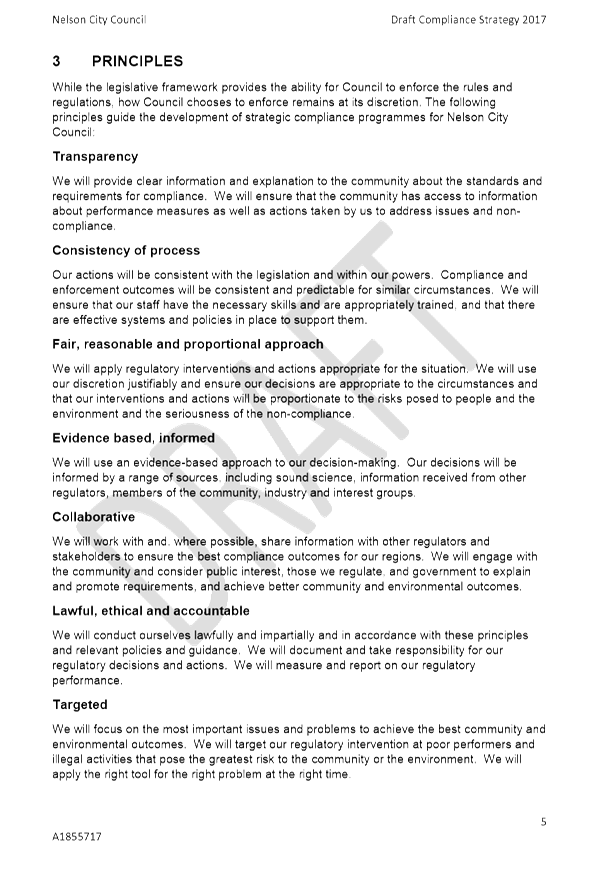


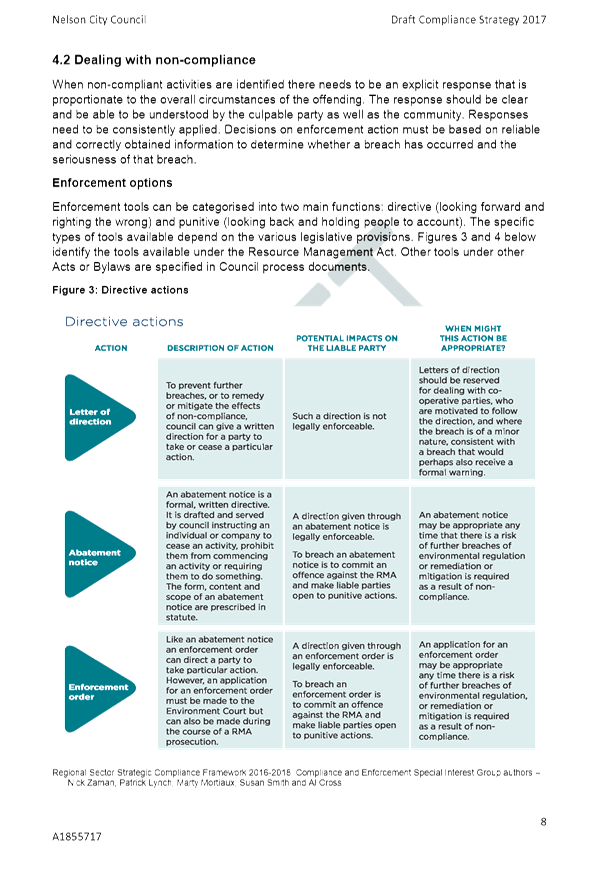
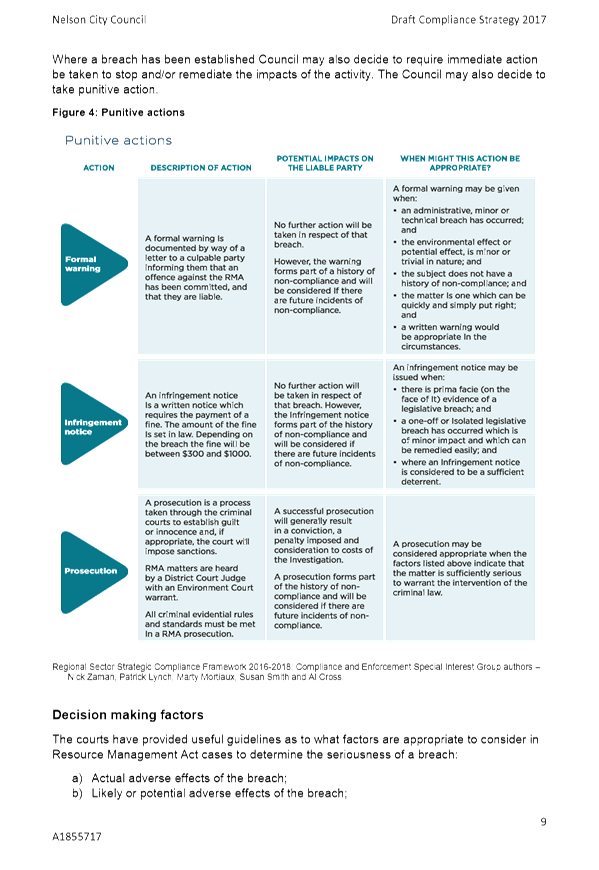
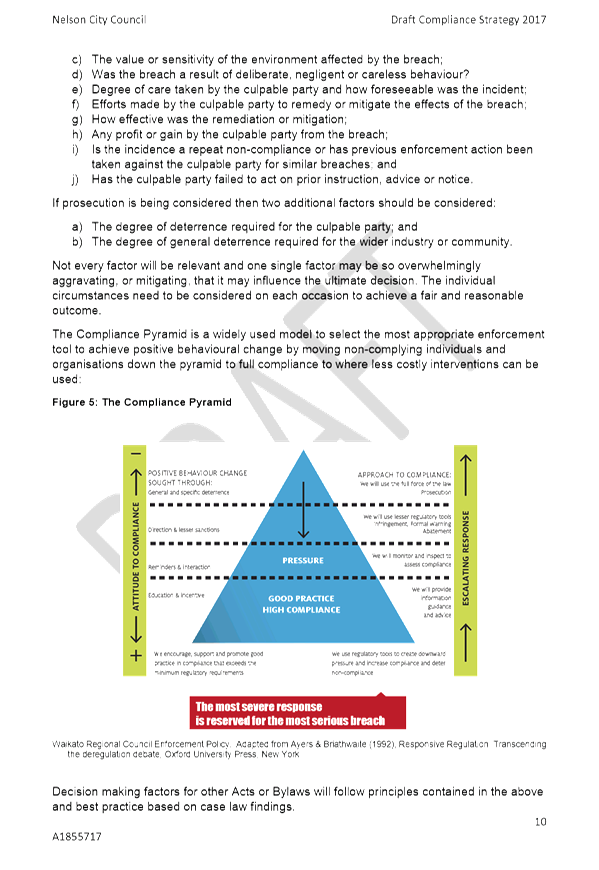
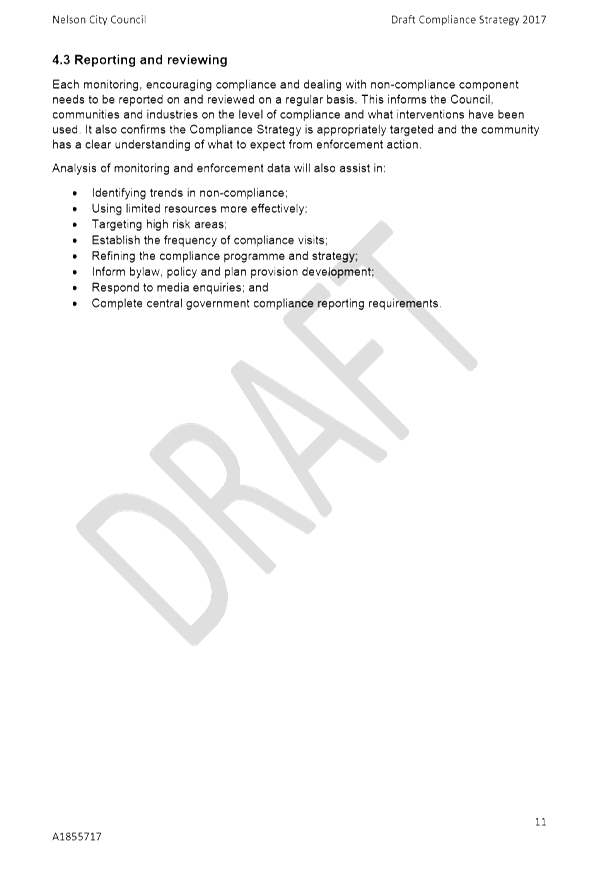
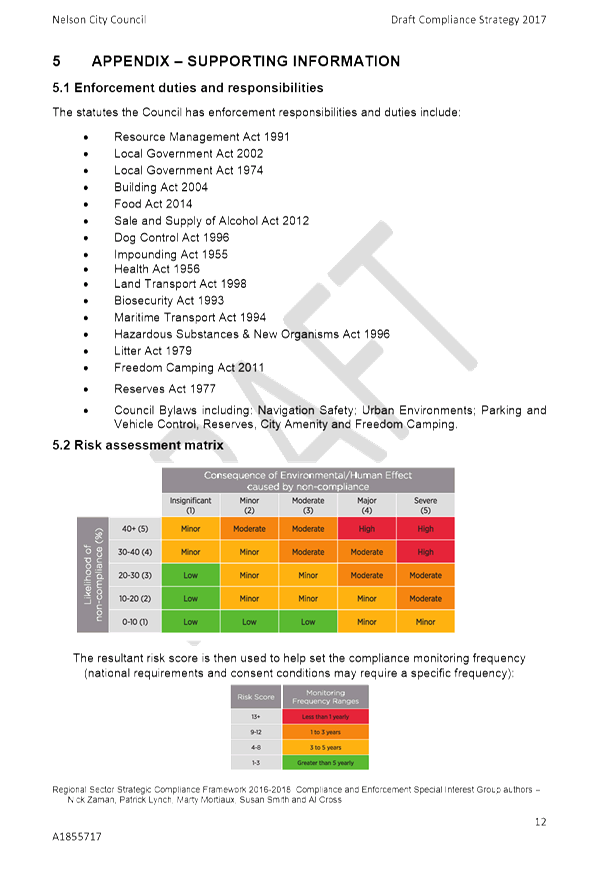
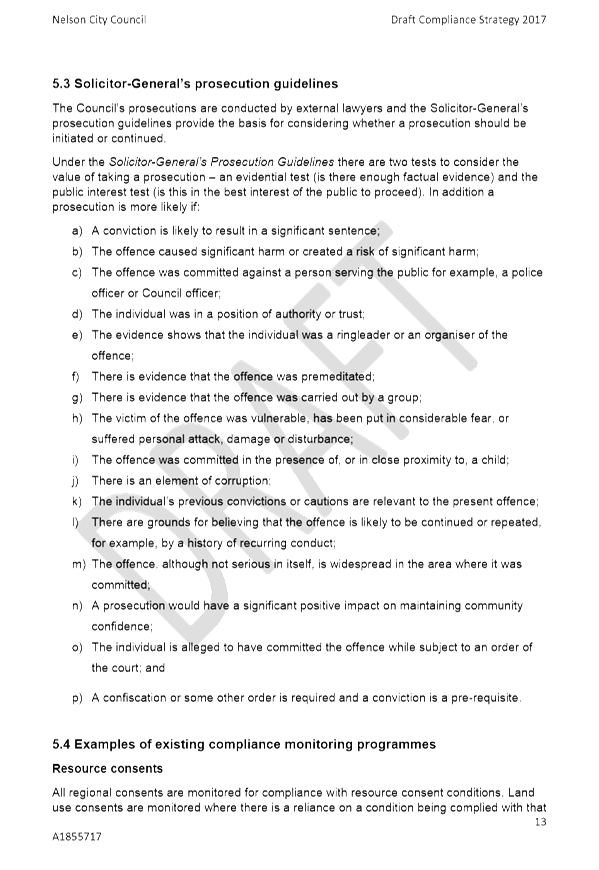
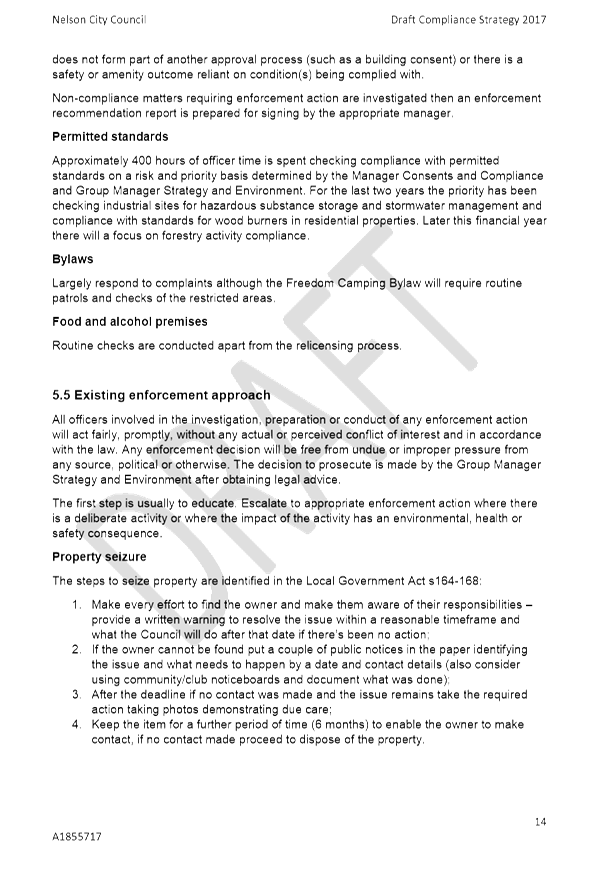

|

|
Planning and Regulatory Committee
23 November 2017
|
REPORT R8477
National
Policy Statement Urban Development Capacity - Quarterly Report
1. Purpose
of Report
1.1 To
ensure decision-makers are well-informed about urban development activity in
both Nelson and Tasman, as required by the National Policy Statement on Urban
Development Capacity (NPS-UDC).
2. Summary
2.1 The
NPS-UDC requires Council to monitor property market indicators on a quarterly
basis, including prices, rents, resource and building consents, and housing
affordability. The attached report for the June 2017 quarter is the second of
these reports.
2.2 The
monitoring report shows that there is an undersupply of residential housing
across the Nelson Urban Area (Nelson and Richmond), that house process and
rents continue to increase, and affordability is still relatively poor.
Residential building consents in Nelson have started to increase, but not
enough to satisfy projected demand.
2.3 Further
investigation is required of the other factors affecting the supply of
affordable homes. These barriers include land banking, lending rules,
construction industry capacity constraints, the markets limited provision of
smaller houses, and rising building costs.
2.4 Commercial
and industrial building activity in the Nelson Urban Area has been relatively
stable since 2010.
3. Recommendation
|
That the Planning and Regulatory Committee
Receives the report National
Policy Statement Urban Development Capacity - Quarterly Report June 2017
(R8477) and its attachment A1852986; and
Agrees
to the report being circulated to the Ministry of Business, Innovation and
Employment and placed on Council’s website.
|
4. Background
4.1 The
National Policy Statement on Urban Development Capacity (NPS-UDC) came into
effect in December 2016. The NPS-UDC includes a policy (PB6) that requires
local authorities to monitor a range of indicators on a quarterly basis
including:
· Prices and rents for
housing, residential land and business land by location and type; and changes
in these prices over time;
· The number of resource
consents and building consents granted for urban development relative to the
growth in population; and
· Indicators of housing
affordability.
4.2 This
policy is to ensure that local authorities are well-informed about demand for
housing and business development and applies to local authorities that have a
medium or high growth urban area within their district or region. Nelson City
has the Nelson Urban Area within its boundaries, and the Nelson Urban Area has
been defined by the NPS-UDC as medium growth.
4.3 Local
authorities are encouraged to publish the results of their monitoring.
4.4 The
Ministry for the Environment has provided guidance on the monitoring
requirements and, together with the Ministry of Business, innovation and
Employment (MBIE), have provided an online dashboard of data on local housing
markets. The online dashboard was publicly released on the MBIE website on 7
July 2017.
4.5 Further
information has been provided from Nelson City Council resource and building
consent data.
4.6 The
report includes data for both Nelson and Tasman local authorities, recognising
the connected, cross-boundary property market both Councils share. The NPS-UDC
also strongly encourages both Councils to work together to implement the
policies.
5. Discussion
Housing Market
5.1 Since
mid-2014, consents for new dwellings have declined while estimated household
numbers have increased, indicating an apparent under-supply of housing in
Nelson. Although new dwellings have exceeded growth in Tasman households, an
overall under-supply in the combined Nelson-Tasman market could be contributing
to an increase in house prices in both areas. This trend has continued over the
last quarter, although on an annual basis building consents for new dwellings
in Nelson have increased.
5.2 Across
the combined Nelson City - Tasman District area, prices increased 13% during
the year ended June 2017, compared with a 12% increase in the year ended June
2016, and a 1% decrease in prices in the year ended June 2015. Nelson and
Tasman experienced similar trends in house prices.
5.3 The
shortage of new housing is despite Nelson having an estimated eight
years’ worth of dwelling capacity on land which is zoned, serviced or
planned to be serviced, and feasible for residential development. Other factors
that can influence house and section prices include:
· land development
and construction costs (especially on hillsides)
· size and quality
of new dwellings
· timing of release
by developers
· ability for
developers to obtain financing
· land banking
· increasing demand
for visitor/non-resident accommodation.
5.4 The
MBIE HAM Buy measure for Nelson and Tasman Districts suggests that housing
affordability was at its worse in 2007/2008, with around 88% of first home
buyer households below the 2013 national benchmark of affordability. Since
then, the measure has been at least 80% for both areas. The measure indicates
that at March 2016, 81% of first-home buyer households in Nelson, and 83% for
Tasman, could not comfortably afford a typical ‘first-home’ priced
house.
5.5 The
MBIE HAM Rent measure for Nelson City and Tasman District suggests that rental
affordability worsened between 2004 and 2014 but has improved in both regions
since then. The measure indicates that at March 2016, 67% of rental households
in Nelson, and 66% for Tasman, cannot comfortably afford typical rents.
Commercial and
Industrial Property Market
5.6 There
is limited information at this stage on prices and rents for business land.
5.7 Commercial
and industrial building activity in the Nelson Urban Area has been relatively
stable since 2010 but has increased recently in Nelson due to consents for two
new large buildings.
6. Options
6.1 Quarterly
monitoring of property market indicators is a mandatory requirement under the
NPS-UDC. Council may like to give feedback on the data and level of detail that
this report has included, and whether additional information could be included.
6.2 Council’s
website will be updated to include the quarterly monitoring report.
Lisa
Gibellini
Team
Leader City Development
Attachments
Attachment 1: A1852986 NPS UDC
Monitoring Report Nelson Urban Area June 2017 Quarter ⇩
|
Important considerations for decision making
|
|
1. Fit with
Purpose of Local Government
Monitoring property market indicators informs Long Term
Plan decision-making on infrastructure projects to ensure sufficient
development capacity is provided to meet future demand for housing and
business land.
|
|
2. Consistency
with Community Outcomes and Council Policy
Monitoring joint indicators with Tasman demonstrates an
understanding we need to collaborate to provide the best and most efficient
service to our communities.
Being well-informed on property market indicators and
urban growth helps achieve the community outcome of an urban environment that
is well planned, including thinking and planning regionally and ensuring
affordable housing. Monitoring the market for business land helps achieve the
community outcome of a region which is supported by an innovative and
sustainable economy.
|
|
3. Risk
The information contained in the report should inform
Council about property market trends. There is some risk in using an
experimental data series for housing affordability but other data sources,
such as the Massey University affordability measure, also indicate the region
is experiencing housing affordability pressures.
There is a risk that the business property market
isn’t well understood at this stage and more work is planned to monitor
prices for different types of business land.
|
|
4. Financial
impact
MBIE data is provided at no cost. The purchase of other
data is of minimal cost and is included in existing budgets.
|
|
5. Degree of
significance and level of engagement
This matter is of low significance because the
recommendation is to receive the report and no other decisions are required.
|
|
6. Inclusion of
Māori in the decision making process
Māori have not been specifically included in the
preparation of this report.
|
|
7. Delegations
The Planning and Regulatory Committee has the
responsibility for considering the District and Regional Plan, which must
give effect to the National Policy Statement on Urban Development Capacity.
|
Item
11: National Policy Statement Urban Development Capacity - Quarterly Report:
Attachment 1
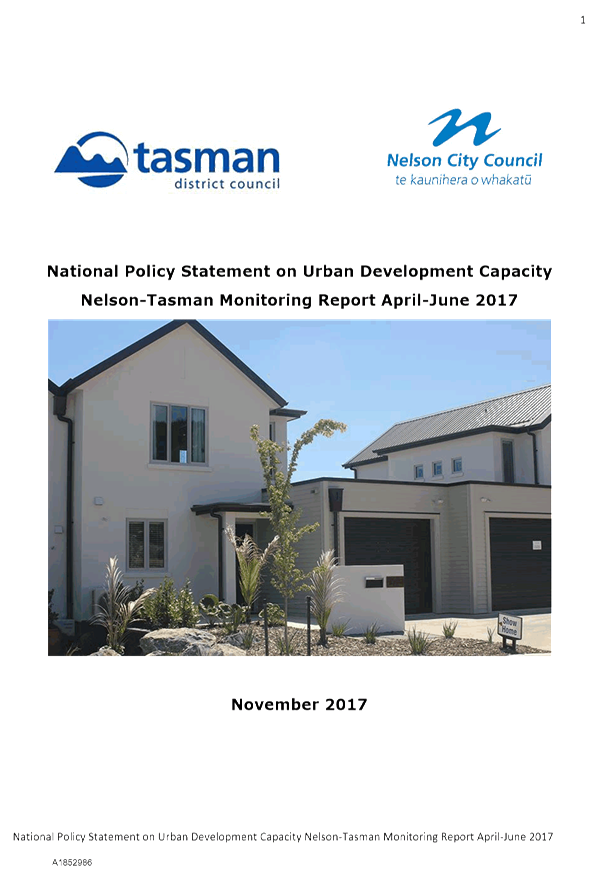
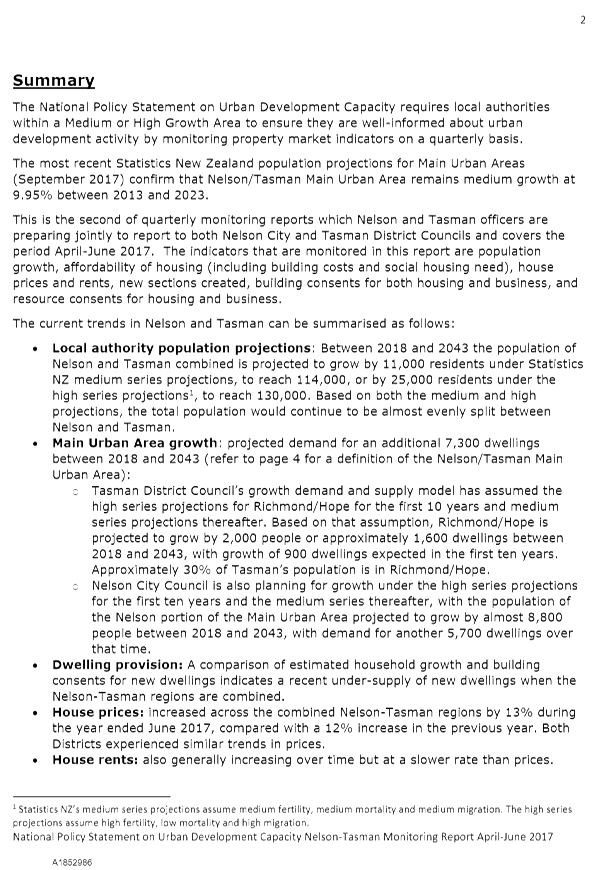
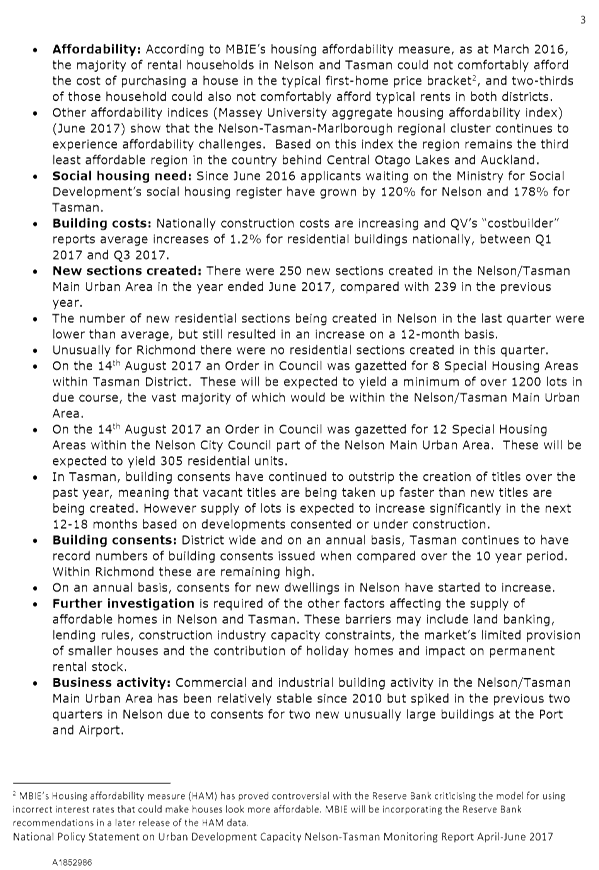
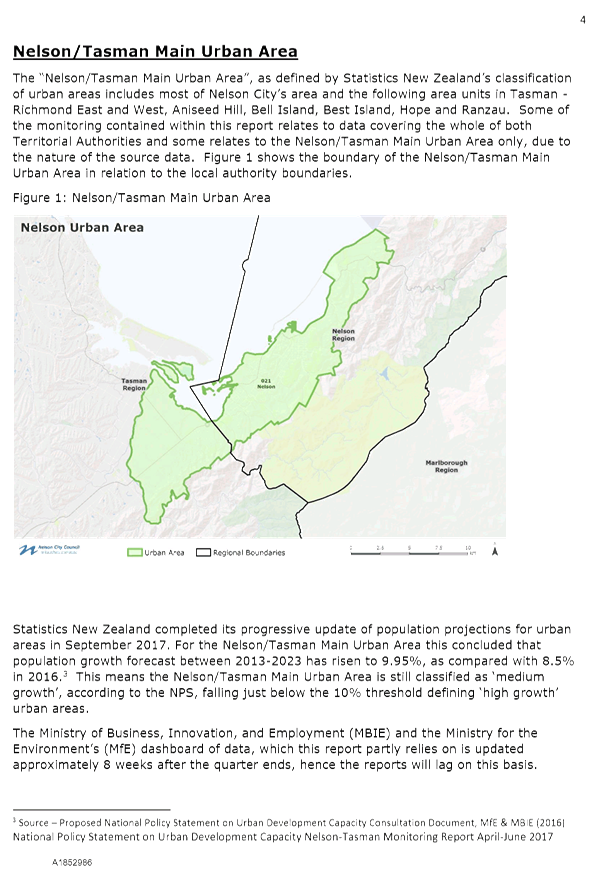
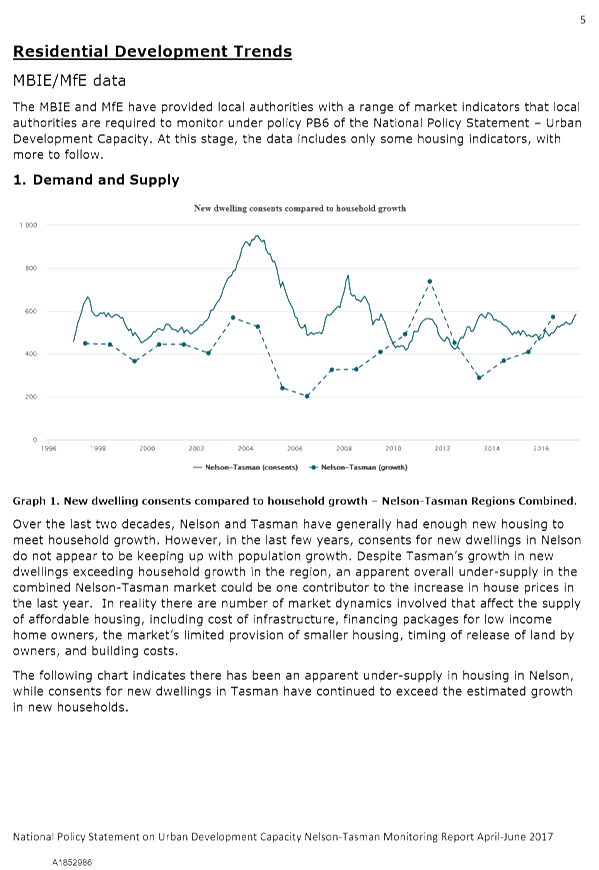
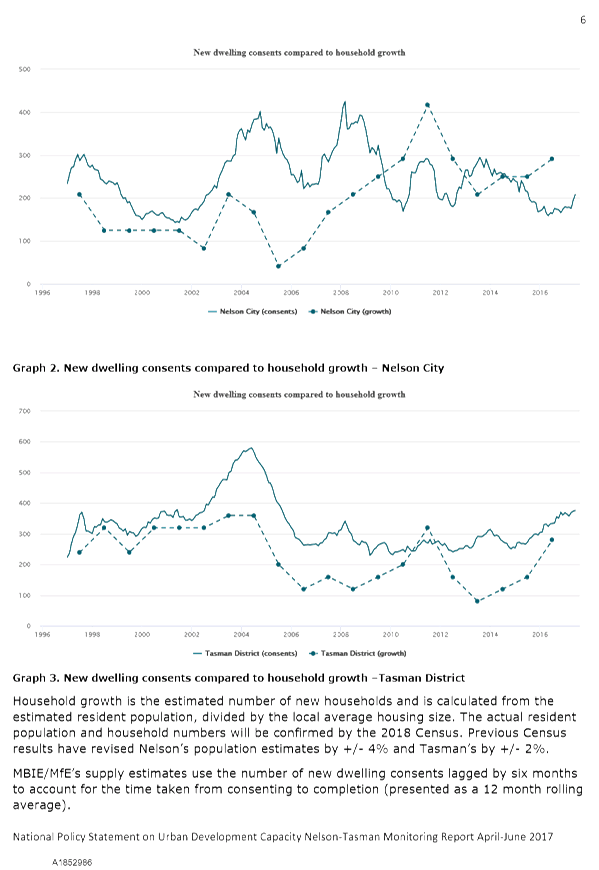
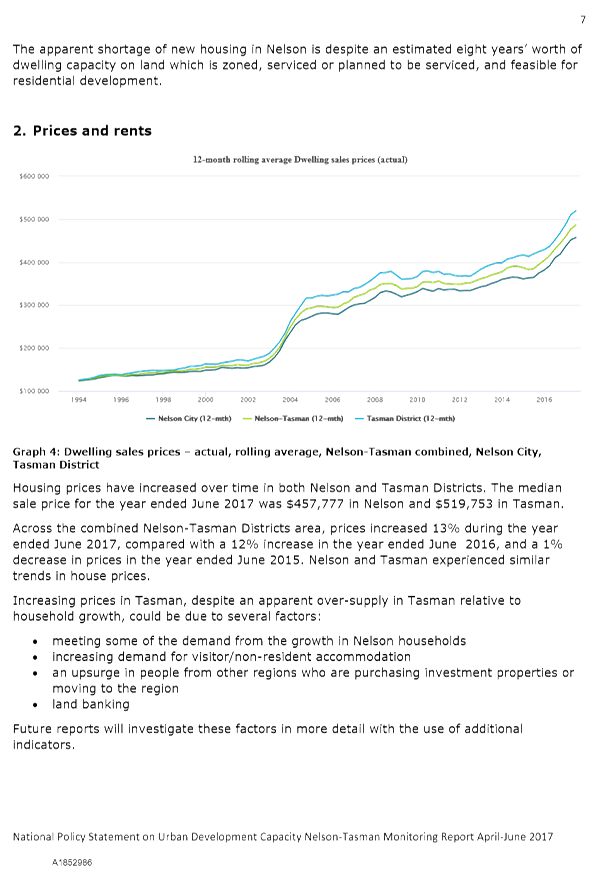
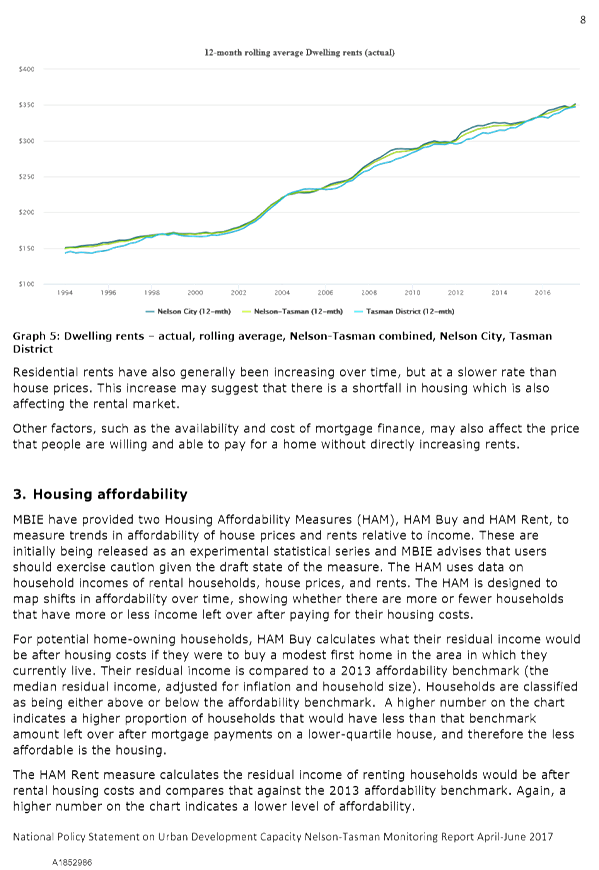
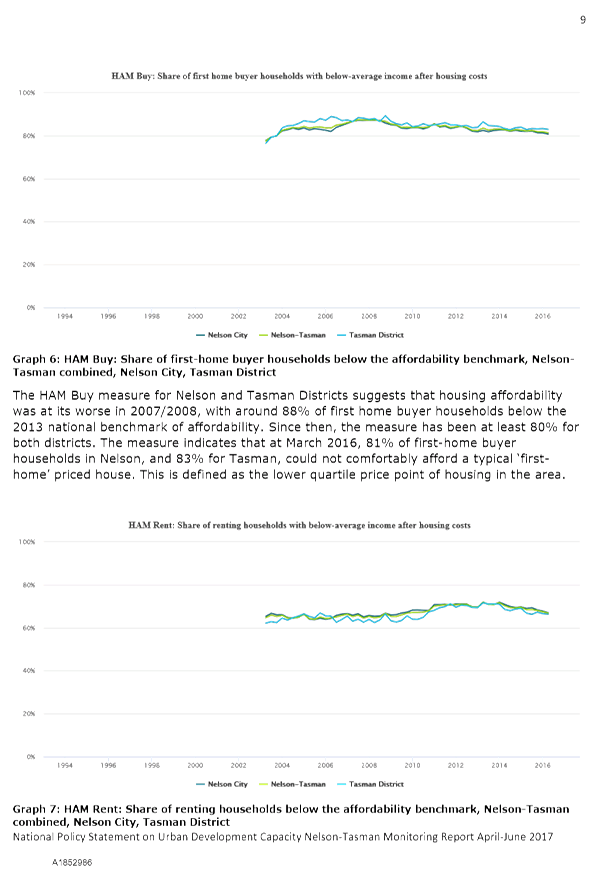
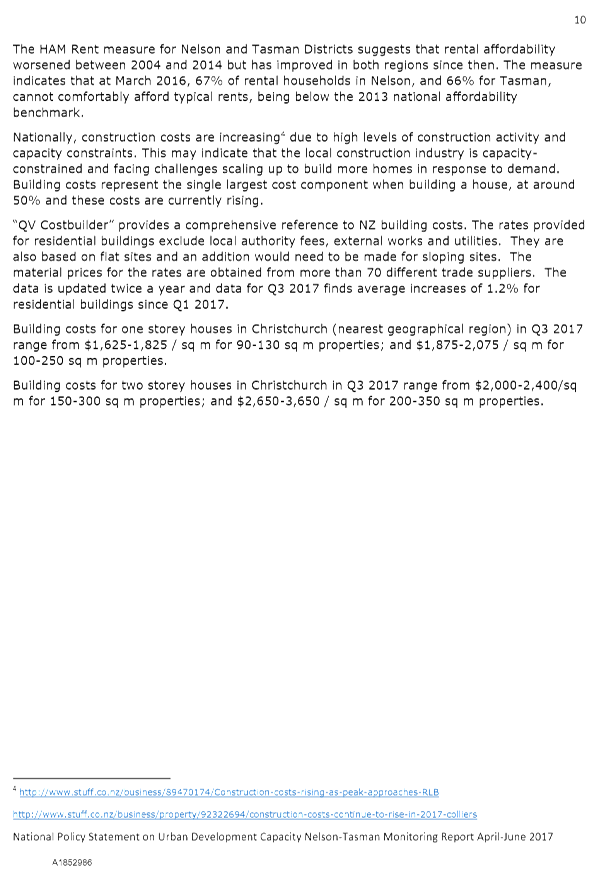
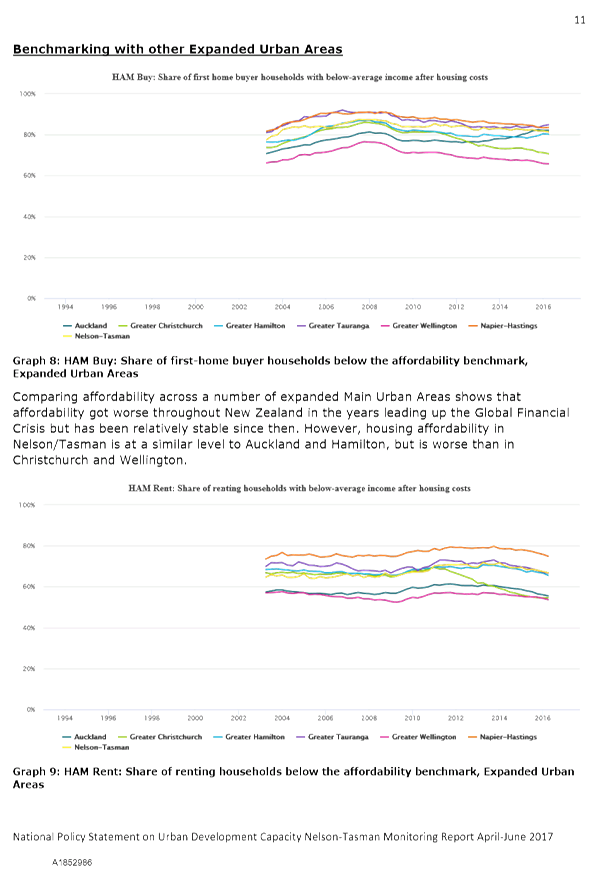
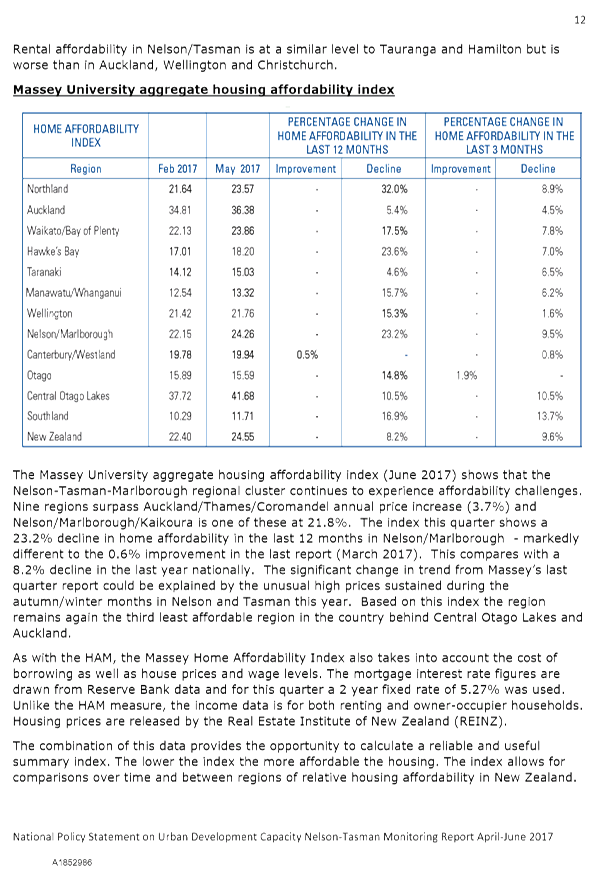
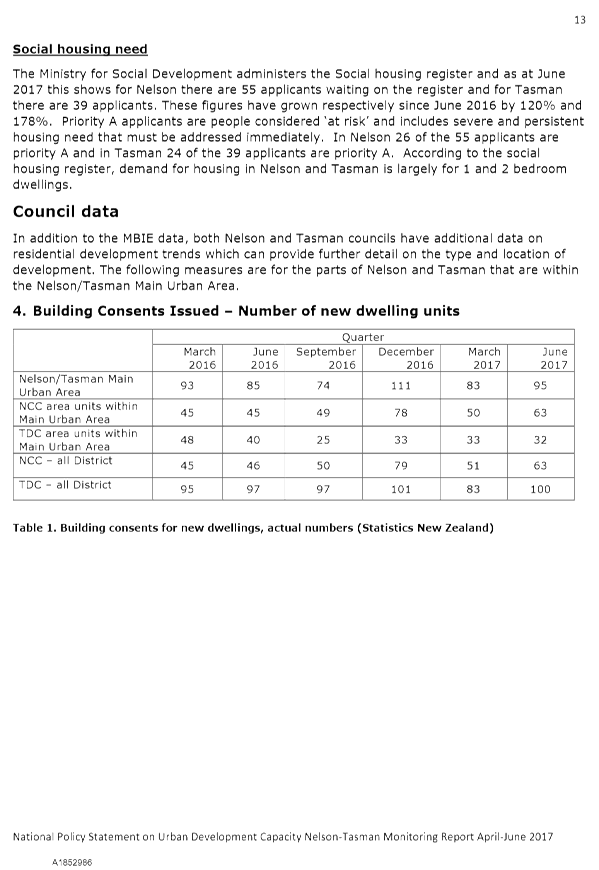
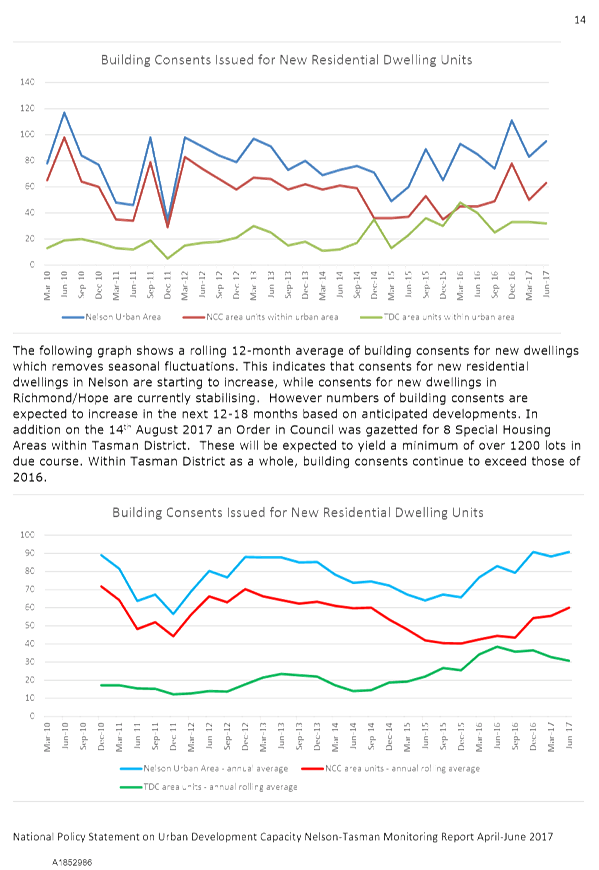
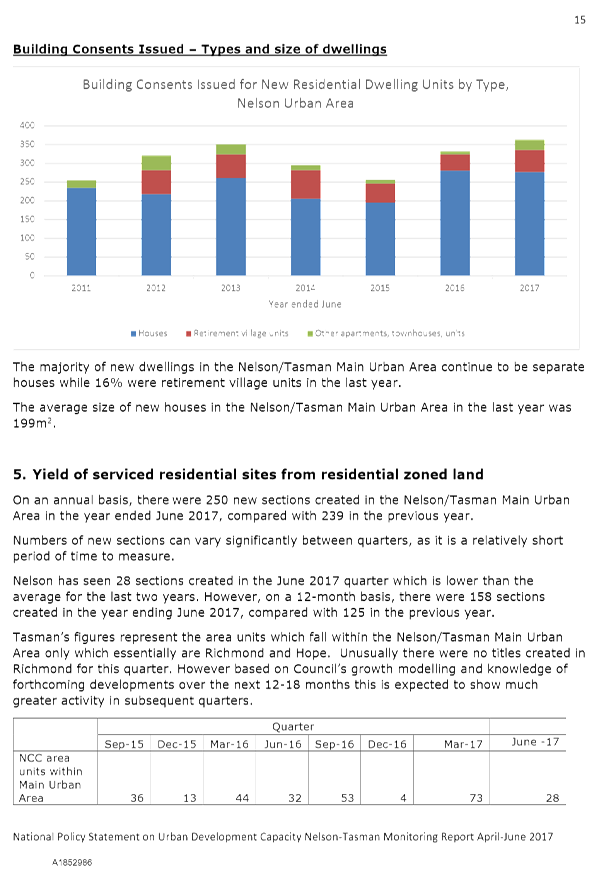
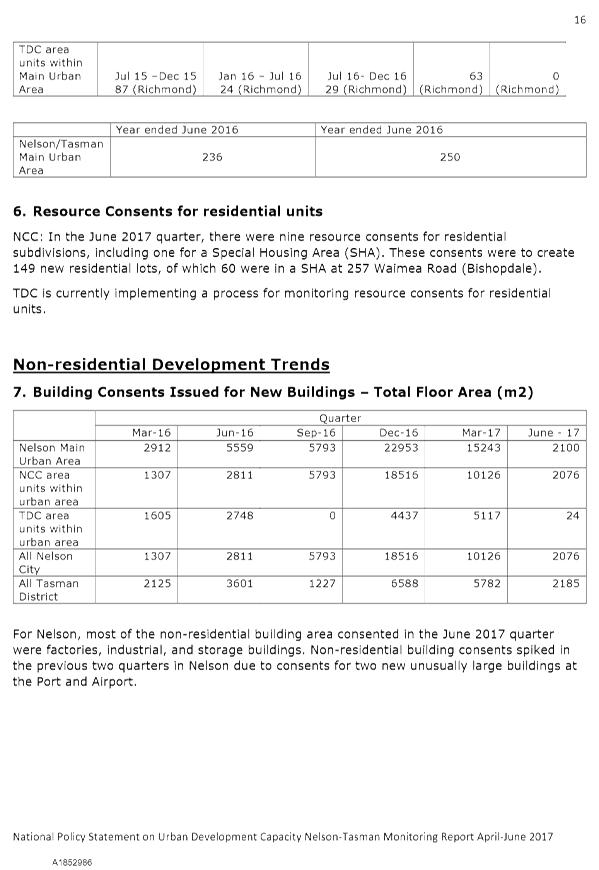
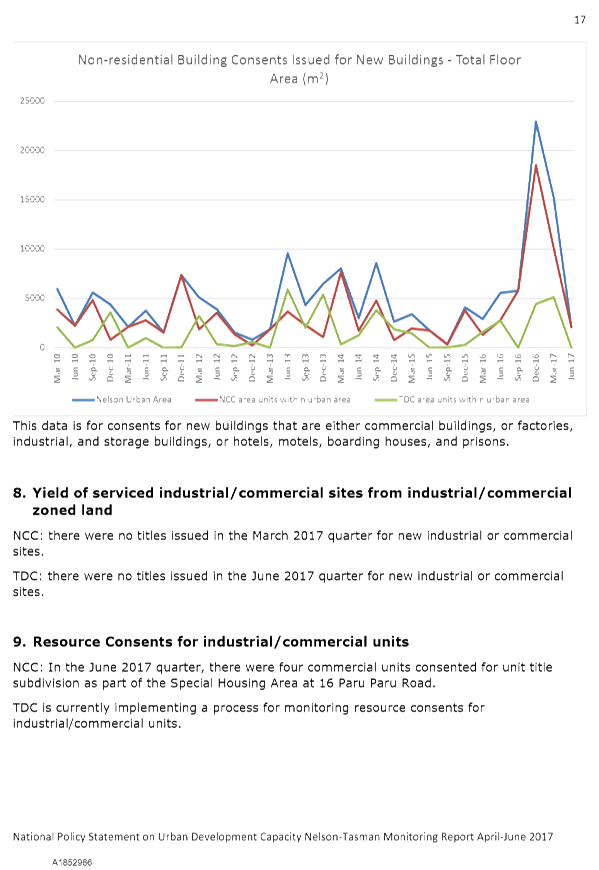
Item 12: Marine and
Coastal Area (Takutai Moana) Act
|

|
Planning and Regulatory Committee
23 November 2017
|
REPORT R8668
Marine
and Coastal Area (Takutai Moana) Act
1. Purpose
of Report
1.1 Councillors
received a briefing on 29 September 2017 from Paul Beverley, Partner with
Buddle Findlay, in relation to the Marine and Coastal Area (Takutai Moana) Act
2011 (MACA). Councillors have requested a short report outlining the
provisions of MACA, implications for the Council and next steps in proceedings.
2. Recommendation
|
That the Planning and Regulatory
Committee
Receives the report Marine and
Coastal Area (Takutai Moana) Act (R8668).
|
3. Discussion
3.1 The
Marine and Coastal Area (Takutai Moana) Act 2011 (MACA) replaced the Foreshore
and Seabed Act 2004. MACA provides for applications to be made for
customary marine title and protected customary rights. These applications
can either be made to the High Court or the Crown. The applications had
to be made by 3 April 2017.
3.2 If
confirmed the rights conferred by customary marine title include:
3.2.1 A
Resource Management Act 1991 permission right;
3.2.2 A
conservation permission right;
3.2.3 A
right to protect wahi tapu;
3.2.4 Rights
in relation to marine mammal watching permits;
3.2.5 Ownership
of minerals other than minerals covered by section 10 the Crown Minerals Act
1991 or pounamu to which section 3 of the Ngai Tahu (Pounamu Vesting) Act 1997;
3.2.6 The
right to create a planning document and rights in relation to a New Zealand
Coastal Policy Statement.
3.3 In
relation to Nelson there have been five applications made by the following
parties:
3.3.1 Trustees
of Te Rῡnanga a
Rangitāne o Wairau Trust on behalf of Rangitāne o Wairau in te Tau
Ihu o Te Waka (Clarence River to Nelson);
3.3.2 Te
Ᾱtiawa o Te Waka-a-Māui
Trust (Westport on the West Coast to the mouth of the Clarence River on the
East Coast);
3.3.3 Te
Runanga a Rangitane o Kaituna (Blenheim to Nelson);
3.3.4 Rihari
Dargaville on behalf of the New Zealand Māori Council members (all of New
Zealand including all off-shore islands); and
3.3.5 Cletus
Maanu Paul on behalf of all Māori (all of New Zealand). (This
application has since been declined).
3.4 Once
an application for customary marine title has been granted, if any resource
consent applications are made within the customary marine title area then the
iwi that have made application must be consulted and their approval obtained by
the applicant. In the meantime, an applicant for a resource consent
within an area that is the subject of a customary marine title application must
notify and seek the views of the iwi applicant group before the resource
consent application may be lodged.
3.5 Once
confirmed the Council must then initiate a process to determine whether to
alter regional plan documents. This can be included as part of the Nelson
Plan process.
3.6 Nelson
City Council along with most other Regional Councils have joined the
proceedings as an interested party. This allows the Councils to be
informed of the proceedings and participate as required.
3.7 Before
18 December 2017 applicants will:
3.7.1 Advise
the Court if they disagree with the list of priority claims;
3.7.2 Advise
the Court of any overlapping claims that should be heard;
3.7.3 File
any amendments they wish to make to their claims.
3.8 By
2 March 2018 the Crown will file and serve:
3.8.1 An
amended notice of appearance for each application;
3.8.2 A
memorandum identifying what applications should be heard together and priority.
3.9 The
Crown is also reviewing which of the applicants for direct engagement it wishes
to engage with (noting the Crown has received approximately 381 such
applications).
3.10 As
an interested party, the Council is not required to take any further action
until February 2018, when it may need to take some procedural steps in response
to amendments made by applicants.
3.11 Throughout
the proceedings, the Council will have the ability to choose its level of
involvement at every stage, and may wish to be more involved in some
proceedings than others as further information emerges. In general the
preliminary applications were drafted to be very broad, however more specific
information will be provided by the applicants over the next few months as the
applications are amended. This will allow the Council to get a clearer picture
of how it may be affected.
4. Conclusion
4.1 The
report is provided for information. As matters progress further updates
will be provided to the Committee.
Clare
Barton
Group
Manager Strategy and Environment
Attachments
Nil
|
Important considerations for decision making
|
|
1. Fit
with Purpose of Local Government
· The report
ensures the Committee remains informed in relation to the Marine and Coastal
Area (Takutai Moana) Act 2011 (MACA). The report provides information
only and requires no decision.
|
|
2. Consistency
with Community Outcomes and Council Policy
The matter aligns with the following community
outcomes: Our unique natural environment is healthy and protected; Our
Council provides leadership and fosters partnerships. A regional perspective
and community engagement.
|
|
3. Risk
The report provides information only and requires no
decision. There is no risk.
|
|
4. Financial
impact
The report provides information only and requires no
decision. There is no financial impact.
|
|
5. Degree
of significance and level of engagement
The report provides information only. The matter is
of low significance
|
|
6. Inclusion
of Māori in the decision making process
The report provides information only. Māori
have not been consulted on this report.
|
|
7. Delegations
This matter falls within the delegation of the Planning
and Regulation Committee.
|
Item 13: Submission on
Proposed Tasman-Nelson Regional Pests Management Plan
|

|
Planning and Regulatory Committee
23 November 2017
|
REPORT R8696
Submission
on Proposed Tasman-Nelson Regional Pests Management Plan
1. Purpose
of Report
1.1 To agree to lodging a submission on the Proposed
Tasman-Nelson Regional Pest Management Plan to ensure pest management issues
facing the Council are adequately addressed.
2. Recommendation
|
That the Planning and Regulatory
Committee
Receives the report Submission
on Proposed Tasman-Nelson Regional Pests Management Plan (R8696); and
Agrees
a submission be prepared on behalf of Council so that pest management issues
for Nelson City are fully considered.
|
3. Background
3.1 After
a process of review established by the Joint Regional Pest Management
Committee, and managed by Tasman District Council as the Council’s pest
management agency, the proposed Tasman Nelson Regional Pest Management Plan
2017-2027 (Proposed Plan) has been notified for public submissions from 4
November to 15 December.
3.2 The
purpose of the Proposed Plan is to provide a framework for efficient and
effective management or eradication of specified organisms in the Nelson and
Tasman Regions. It identifies the organisms to be classified as pests and
managed on a regional basis.
3.3 At
a late stage in the Proposed Plan preparation process questions were asked
regarding wilding conifer, goats and Taiwan Cherry and whether what was in the
Proposed Plan adequately addressed these matters in the Nelson context.
In order to ensure the Plan appropriately reflects the Nelson context it is
proposed to lodge a submission on behalf of Council.
4. Discussion
4.1 The
Proposed Plan provides an excellent opportunity to ensure the Council’s
pest management objectives are aligned with its biodiversity programme, such as
Nelson Nature. In particular, the management of a number of pests require
further consideration than currently covered by the Proposed Plan, namely:
4.1.1 Taiwan
Cherry – the Proposed Plan provides for controlling this invasive pest to
the north-east of the city only. Further consideration is needed to determine
whether this is sufficient to address the risk, such as eradication across a
larger area or whole region.
4.1.2 Wilding
conifers – the Proposed Plan provides for control of 4 species (Douglas
fir, Lodgepole pine, Radiata pine, and Scots pine) in areas of Mt Richmond
Forest Park, Abel Tasman National Park and Nelson Lakes National Park.
Consideration should be given to whether the Dun Mountain Mineral Belt be
included alongside these areas.
4.1.3 Goat
control is not included at all in the Proposed Plan and further consideration
is required as to whether a site led approach is an appropriate mechanism to
deal with the issue of goats destroying plants on private or Council
land.
4.2 As
the Proposed Plan has just been notified and submissions close on 15 December
there has not been adequate time to prepare a draft submission for
consideration by the Committee. The next Committee meeting is in February
2018 meaning the submission date will have passed. It is proposed a
submission be prepared by Officers before the closing date addressing the
issues identified in paragraph 4.1 above.
4.3 Costs
of preparing a submission will be covered within existing budgets.
5. Options
5.1 There
are two options considered below.
|
Option 1: Submit on the
Proposed Plan
|
|
Advantages
|
· Enables
Council to ensure Plan process will explore and consider the most effective
ways of managing pests of concern
|
|
Risks and Disadvantages
|
· Some
time and resource required to prepare a submission although this is minimal.
|
|
Option 2: Do not submit on the
Proposed plan
|
|
Advantages
|
· Saves
time and resource.
|
|
Risks and Disadvantages
|
· Opportunity
to rigorously consider the above issues and explore best pest management
options would be lost.
|
5.2 It
is recommended that a submission is made. As these are Council issues it
would be helpful if the submission is made by Council.
6. Conclusion
6.1 It
is recommended that a submission be prepared on behalf of Council.
Richard
Frizzell
Environmental
Programmes Officer
Attachments
Nil
|
Important considerations for decision making
|
|
1. Fit
with Purpose of Local Government
This report and recommendation achieve consideration
of rigorous management and control of pests that threaten the region,
ensuring environmental and economic risks are effectively addressed.
|
|
2. Consistency
with Community Outcomes and Council Policy
The eradication and effective management of harmful
organisms helps ensure our unique natural environment is healthy and
protected, which is one of the Community Outcomes.
The report is consistent with Nelson 2060. The
recommendations contribute to Goal three: our natural environment –
air, land, rivers and sea – is protected and healthy.
|
|
3. Risk
The report seeks to reduce risk posed by pests to
Nelson by ensuring full consideration of effective control measures.
|
|
4. Financial
impact
Costs will be covered within existing budgets.
|
|
5. Degree
of significance and level of engagement
This matter is of low significance. It ensures
Council takes the opportunity to improve consideration of pest management
issues and options as available to it.
|
|
6. Inclusion
of Māori in the decision making process
Consultation with Maori has not been undertaken or
considered necessary.
|
|
7. Delegations
The Planning and Regulatory Committee has the
responsibility for considering Biosecurity. The Planning and Regulatory
Committee has the power to decide this matter
|
Item 14: Nelson
Biodiversity Strategy Draft
|

|
Planning and Regulatory Committee
23 November 2017
|
REPORT R8704
Nelson
Biodiversity Strategy Draft
1. Purpose
of Report
1.1 To
consider the draft Nelson Biodiversity Strategy (the Strategy) and to approve
the Strategy in principle.
2. Discussion
2.1 The
Nelson Biodiversity Forum (the Forum) is a 31 member organisation working
together to identify and align actions to improve biodiversity in the Nelson
area.
2.2 Council
is a member of the Forum and is represented on the Forum by three Councillors
and several Council officers.
2.3 The
Forum develops and works toward a strategy, the Nelson Biodiversity Strategy,
which aims to align existing actions under a common vision and introduce new
actions to address priority issues related to biodiversity management in
Nelson.
2.4 The
Forum is undertaking the third review of the Strategy and has developed a draft
Strategy (Nelson Biodiversity Strategy) for the next three years.
Workshops have been held since January 2017 compromising Forum members,
including Councillors and officers.
2.5 The
draft Strategy sets out the goals, objectives and outcomes agreed by the Forum
and sets out actions to achieve intermediate objectives.
2.6 The
Forum has identified a “lead” for each action. Being a
“lead” commits the agency representative on the Forum to act as a
focal point for initiating action and update the Forum on progress, however it
does not mean that an agency will be the primary provider of resources to
complete an action.
2.7 The
draft Strategy identifies Council as a lead for a number of actions, most of
which are already part of Council’s existing funded targeted biodiversity
programmes, e.g. Nelson Nature and Project Maitai, and/or are consistent with
Council’s responsibilities as a unitary authority.
2.8 The
Forum plans to agree on a final draft version of the Strategy, including
assignment of ‘leads’ to all actions, at its next meeting on Monday
27th November. Following this, the agency representatives will take
the final draft Strategy, including responsibilities for ‘leading’
actions, back to their agency for formal approval.
2.9 Note
the track changes in the attached document will be provided to the Biodiversity
Forum for consideration and inclusion.
3. Recommendation
|
That the Planning and Regulatory
Committee:
Receives the report Nelson
Biodiversity Strategy Draft (R8704)
and its attachment (A1861351); and
Approves
the draft Nelson Biodiversity Strategy 2017-2020 in principle.
|
4. Options
|
Option 1: Approve Strategy in
principle (preferred option)
|
|
Advantages
|
· Council
demonstrates its support of the Nelson Biodiversity Forum
|
|
Risks and Disadvantages
|
· There
are no risks
|
|
Option 2: Do not approve
Strategy in principle
|
|
Advantages
|
· There
are no advantages
|
|
Risks and Disadvantages
|
· Council
is not seen to support the process of the Nelson Biodiversity Forum
· Nelson
Biodiversity Forum continues to develop the Strategy without Council’s
involvement
|
|
Option 3: Recommend changes to
Strategy
|
|
Advantages
|
· Strategy
takes into account issues that may not have been discussed by the Forum in
the development of the Strategy to date
|
|
Risks and Disadvantages
|
· May
delay the timeframe for completion of the final Strategy
|
Leigh
Marshall
Environmental
Programmes Advisor
Attachments
Attachment 1: A1861351 Nelson
Biodiversity Strategy Draft ⇩
|
Important considerations for decision making
|
|
1. Fit
with Purpose of Local Government
Participation in the Nelson
Biodiversity Forum fits with the role of Local Government as the partnership
approach, focused on better environmental outcomes for the region, aims to
meet the current and future needs of the community at a local level.
|
|
2. Consistency
with Community Outcomes and Council Policy
The Nelson Biodiversity
Strategy/Forum aligns with all four themes within Nelson 2060, and with a
number of Community Outcomes including:
· Our unique natural environment is healthy and
protected
· Our communities are healthy, safe, inclusive
and resilient
· Our Council provides leadership and fosters
partnerships, a regional perspective, and community engagement
· Our region is supported by an innovative and
sustainable economy
|
|
3. Risk
There are no risks associated
with this decision.
|
|
4. Financial
impact
There are no financial
implications associated with this decision. Agreeing to the Strategy
“in principle” does not commit the Council to any specific course
of action. Actions within the Strategy are the responsibility of all 31
Partners to the Strategy.
|
|
5. Degree
of significance and level of engagement
This matter is low significance
because many of those organisations within the community that are concerned
with the matters in the Strategy (and which themselves have a broad outreach
into the community) have been part of its development. Therefore there is no
further consultation required on the document at this stage.
|
|
6. Inclusion
of Māori in the decision making process
There are iwi partners that
attend the Forum, and the Strategy has been discussed at a Nelson City
Council Iwi Working Group (Nelson Plan) meeting, and circulated subsequent to
that meeting.
|
|
7. Delegations
The Planning and Regulatory
Committee/ has the responsibility for considering matters relating to the
environment, and to biodiversity specifically. The Planning and Regulatory
Committee has the power to make a recommendation to Council on this matter.
|
Item
14: Nelson Biodiversity Strategy Draft: Attachment 1
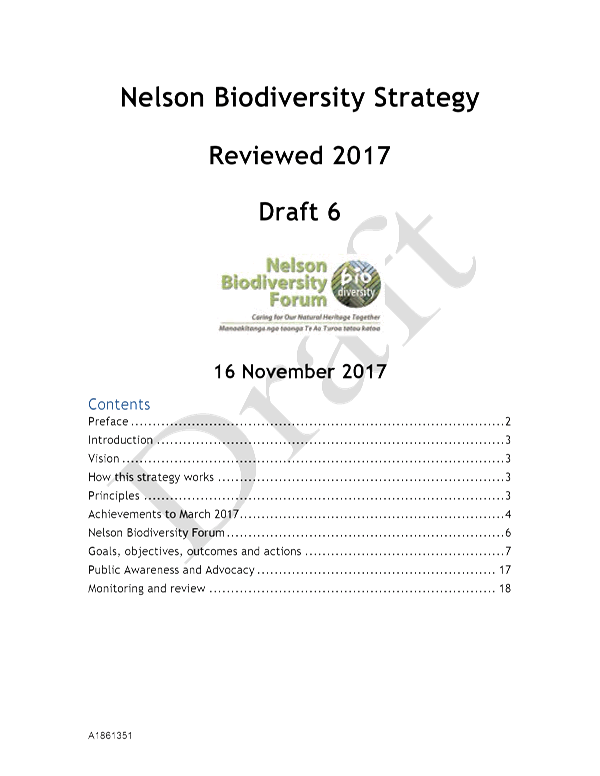


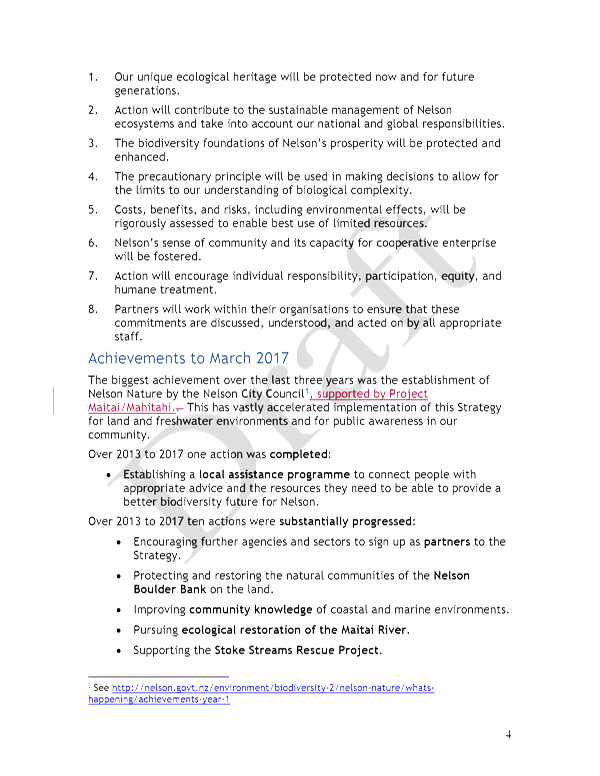
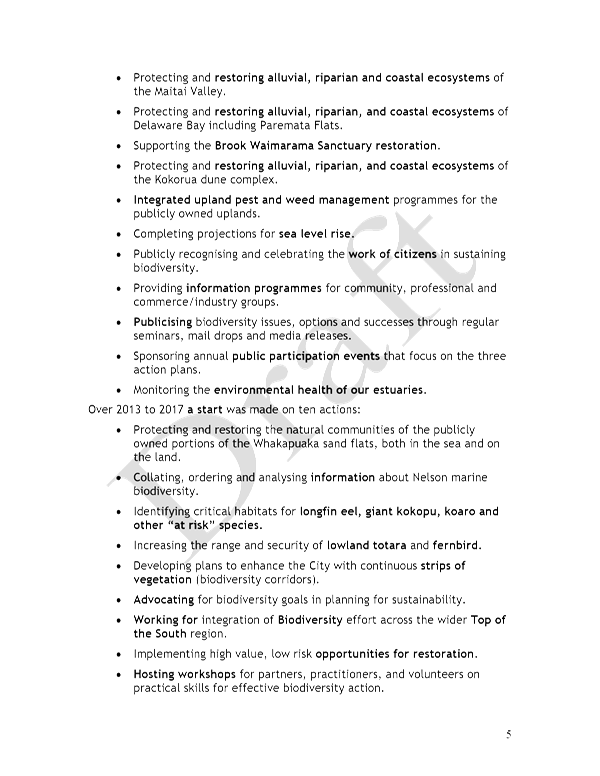

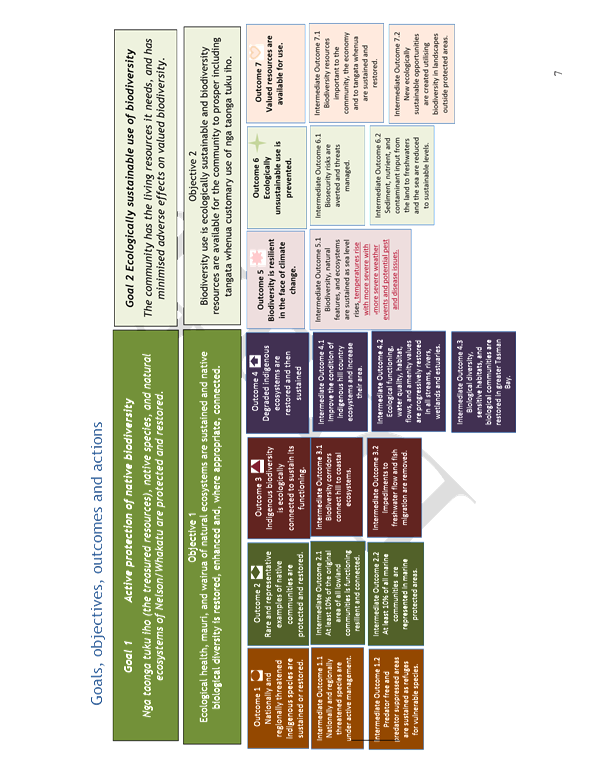
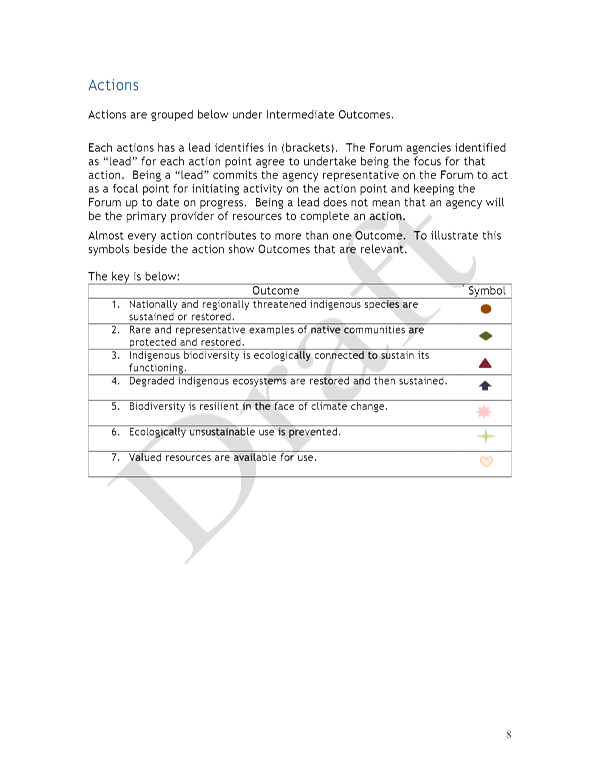
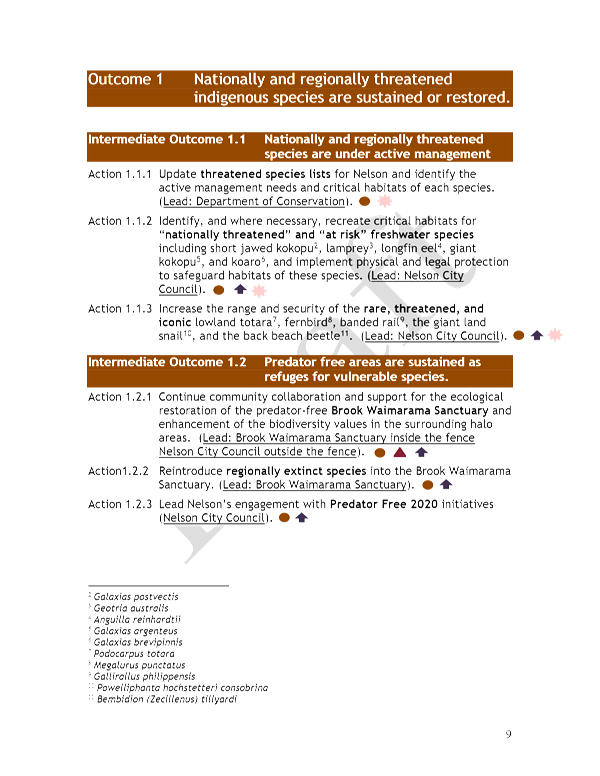
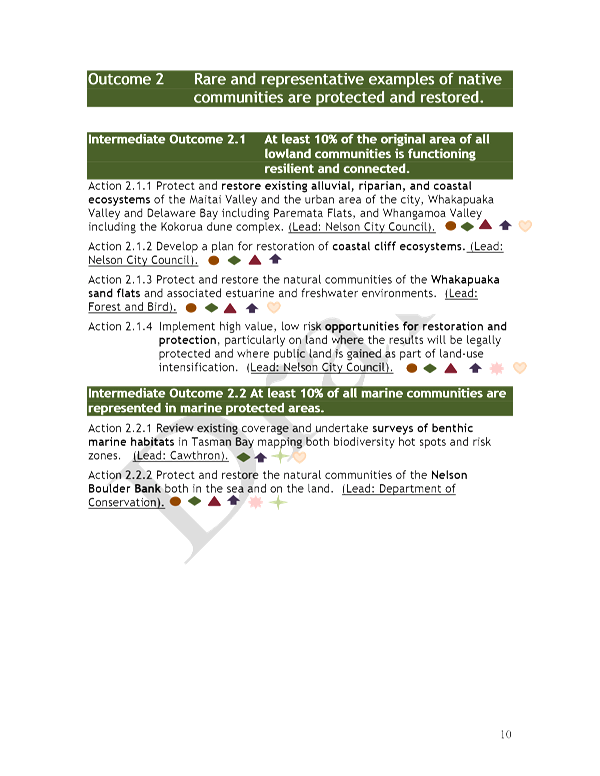
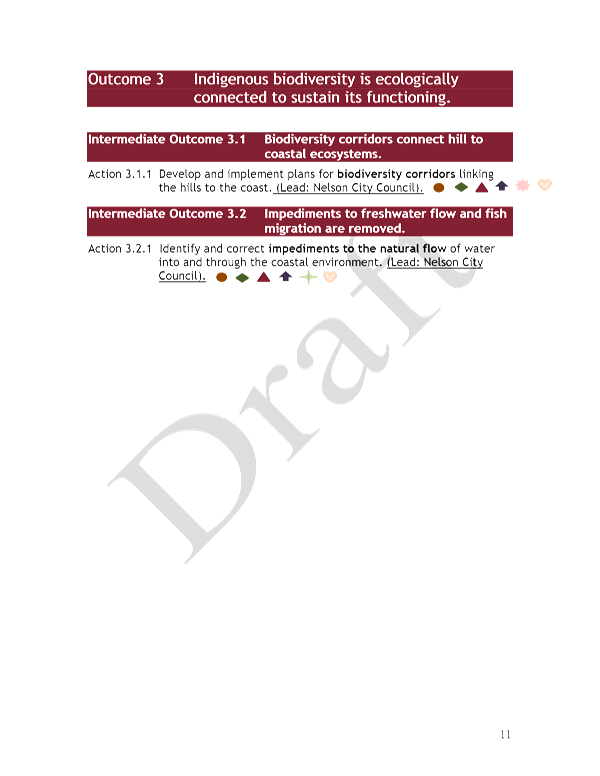
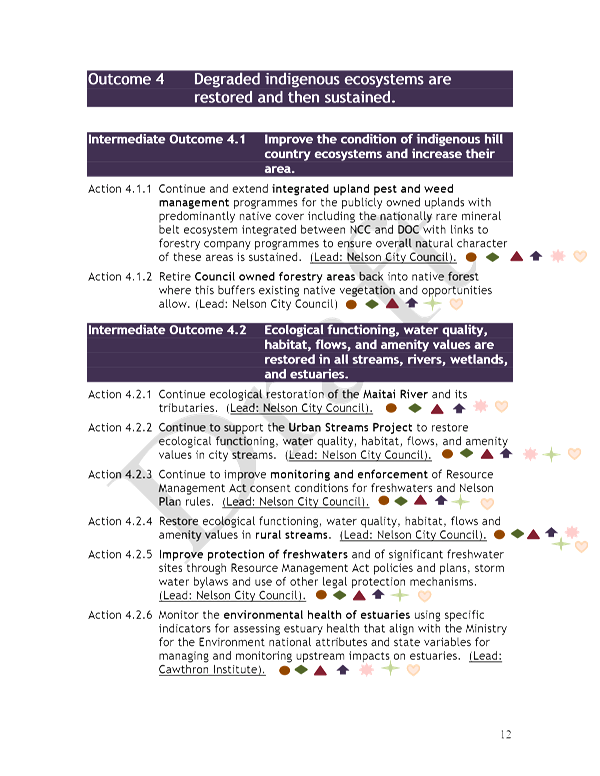
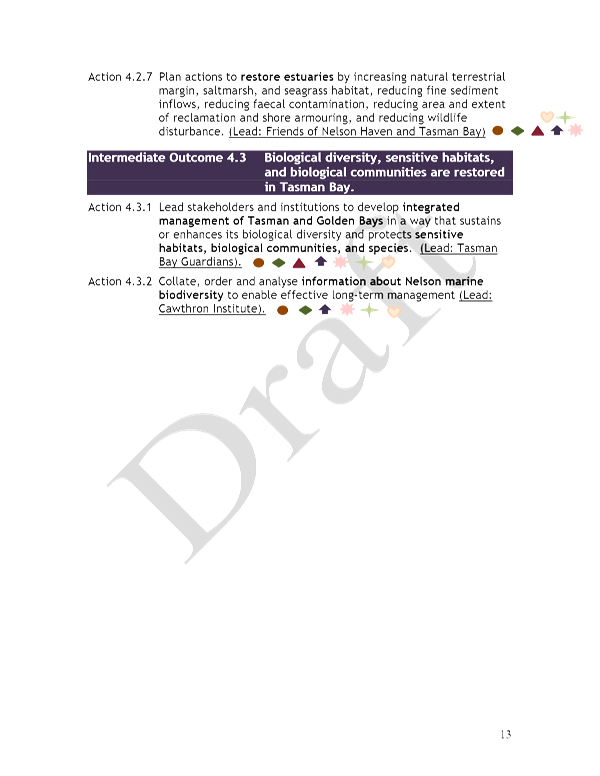
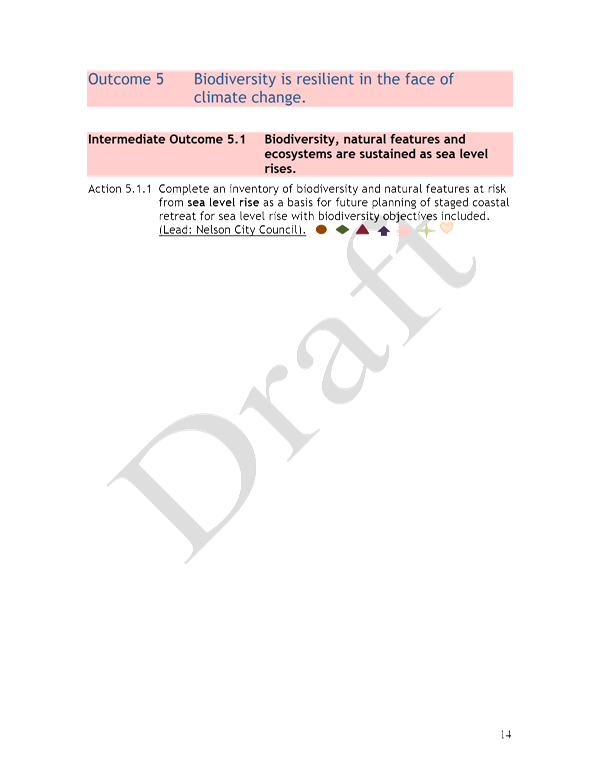
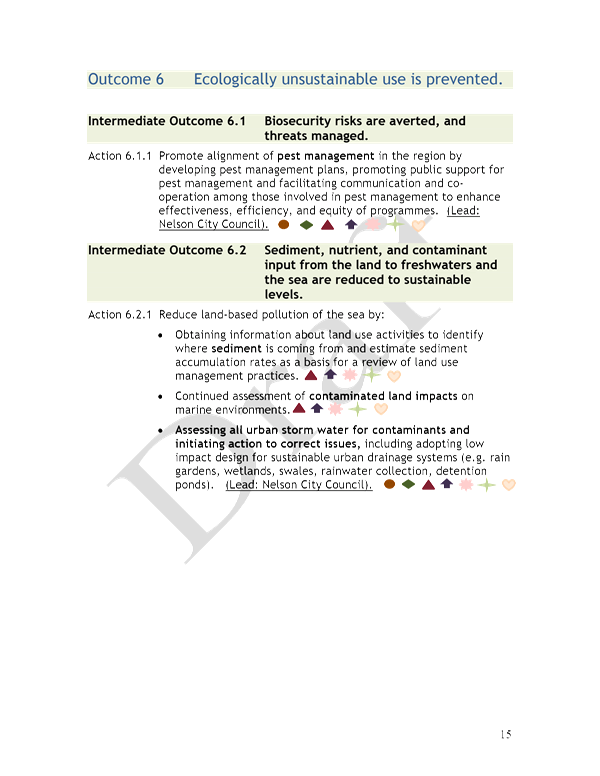
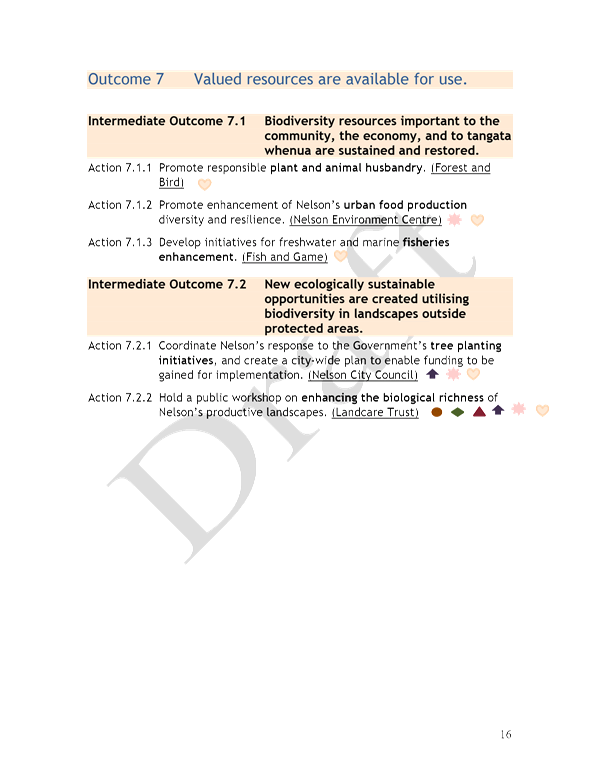
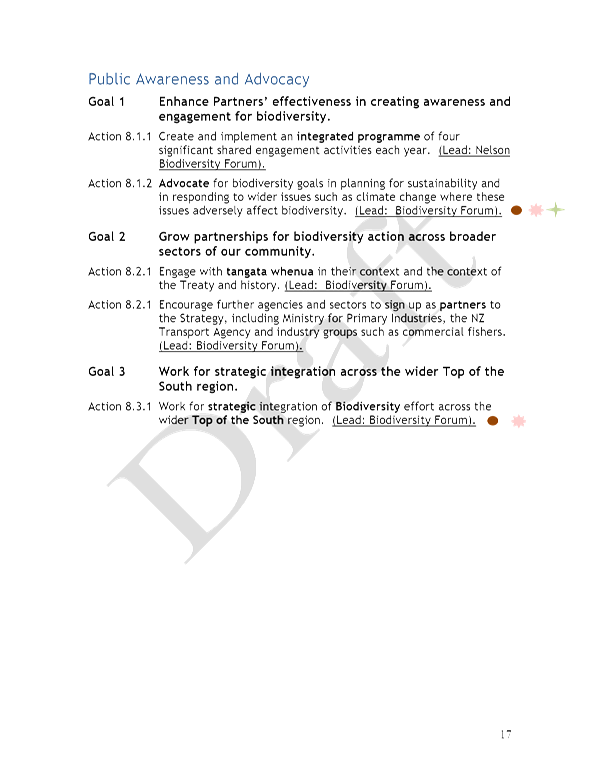
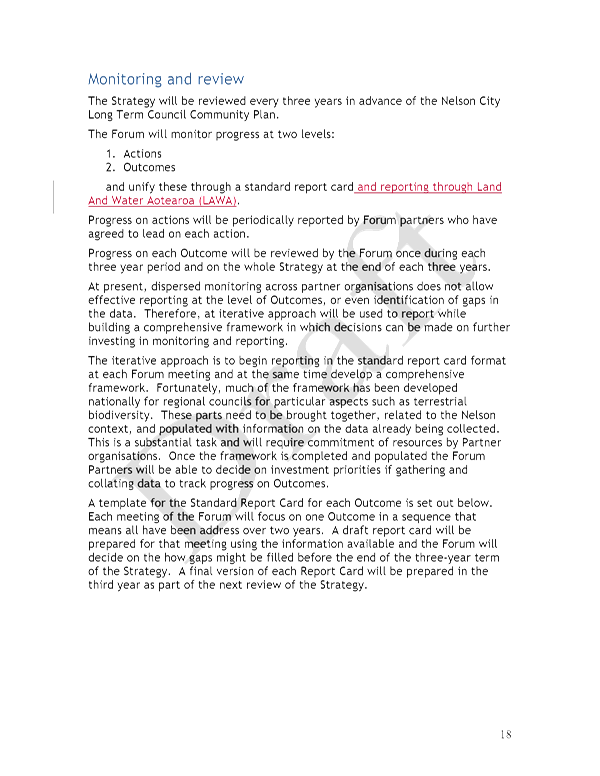
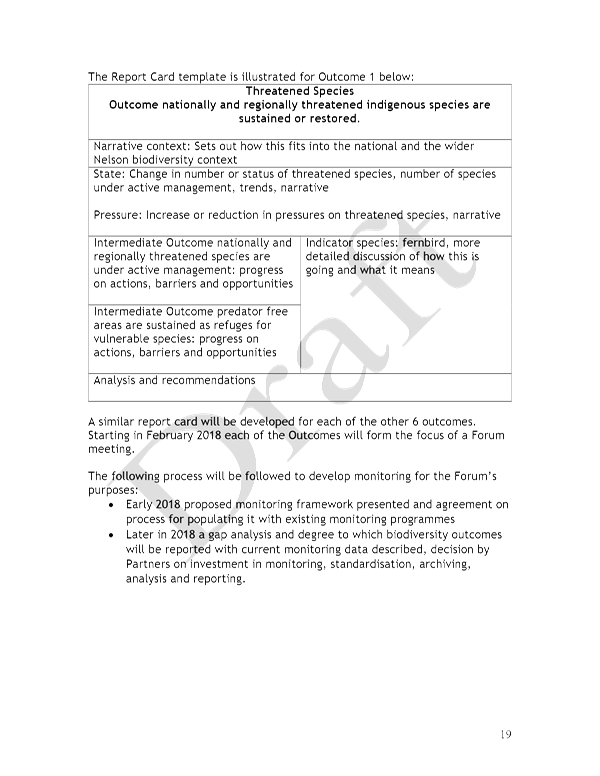





|

|
Planning and Regulatory Committee
23 November 2017
|
REPORT R8520
Nelson
Plan Resourcing
1. Purpose
of Report
1.1 To
seek additional resourcing in 2017/2018 to support the development of the
Nelson Plan.
2. Summary
2.1 An
increase of $600,000 in Nelson Plan budget is sought for the 2017/2018
financial year to enable the release of a draft Nelson Plan, bring the
peer/legal review and cost benefit analysis forward to this financial year, and
the need to engage consultants to cover significant staff vacancies.
2.2 This
$600,000 increase in funding for 2017/2018 will be partially offset by $300,000
by reducing the 2018/2019 projections for the cost of the peer/legal review and
cost benefit analysis. Further savings may also be achieved by utilising
staff vacancy budget from 2017/2018 and moving towards a staff model
(increasing staff numbers and reducing consultant numbers) in 2018/2019.
2.3 While
the 2017/2018 budget is proposed to increase by $600,000 it is projected that
the overall budget for the Nelson Plan will increased by $400,000 over years
2015/2016 to 2020/2021. This is largely due to a reduction in litigation
costs anticipated in 2019-2021 by increasing the budget this financial year to
ensure that the Nelson Plan is more technically robust and supported by iwi
partners and key stakeholders.
2.4 It
is recommended that Council continue with the Nelson Plan timeline reported to
the Planning and Regulatory Committee on 3 October 2017. It is also
recommended that while a consultant model is used for 2017/2018 that
increasingly as staff are recruited into vacancies the work is undertaken to a
greater degree in-house. It is also recommended the proposed Planning
Adviser role be brought forward to 2017/2018.
2.5 The
approach summarised above will ensure that the Nelson Plan meets statutory
requirements, is fit for purpose, and increases the likelihood of broad support
for the Plan by iwi partners, the wider community, and key stakeholders.
3. Recommendation
|
That the Planning and Regulatory Committee
Receives the report Nelson Plan
Resourcing (R8520) and its
attachment (A1858783).
|
Recommendation to Council
|
That the Council
Allocates
an additional unbudgeted $600,000 for the development of the Nelson Plan in
the 2017/2018 financial year; and
Notes
that some increases in the 2017/2018 financial year will be offset by
reducing budget projections for 2018/2019 by $300,000 and savings
in consultant costs by employing an additional staff member and as
recruitment of vacancies is achieved.
|
4. Background
4.1 Council
decided to undertake an integrated review of Nelson’s resource management
plans at the end of 2013. Approximately $3.6million was allocated for the
development of the Nelson Plan in years one (2015/16) to six (2020/21) of the
2015-2025 Long Term Plan. This funding was based on an ambitious
timeframe resulting in notification in 2016/2017 and decisions in 2018/2019 as
outlined Attachment 1.
4.2 The
original Nelson Plan programme did not include the release of a draft plan
ahead of public notification.
4.3 The
Nelson Plan programme (time, cost, scope) has been adjusted as the development
of the Plan has developed. For example the Council deferred the
development of the Nelson Plan in 2015/16 for six months so that the Woodburner
Plan Change (Plan Change A3) could be prioritised at a cost of approximately
$200,000.
4.4 Attachment
1 summarises the key timeline and budget changes to the Nelson Plan programme
from 2015/2016-2020/2021.
4.5 There
have also been a range of other factors that have influenced the Nelson Plan
programme. These factors were most recently outlined to the Planning and
Regulatory Committee on 3 October 2017 when the Committee considered whether
the timeline of the Nelson Plan should be adjusted to provide for notification
in late May 2019 rather than January 2018.
4.6 The
timeline has been adjusted for a number of reasons including:
· The
need to extend workshop timeframes so that the Council can meaningfully engage
on the draft Plan content
· The
need to incorporate additional changes resulting from national policy changes
such as National Environment Standard Plantation Forestry, National Policy
Statement for Freshwater and the National Policy Statement Urban Development
Capacity.
· The
need for additional engagement with potentially affected landowners and
stakeholders
· New
statutory obligations to provide a draft of the Plan to iwi prior to public
release
· There
has been a desire for greater quality control to ensure a robust Plan including
independent legal and peer reviews, consent testing, and cost benefit analysis
of the draft Plan provisions.
4.7 A
summary of the Nelson Plan timeline options considered in the 3 October 2017
report is included in the options section of this report below.
4.8 Further
work has now been undertaken to more carefully consider the financial
implications of changing the timeline and scope of the Nelson Plan.
5. Discussion
5.1 The
timeline of the Nelson Plan has been set so that a good quality plan can be
notified ahead of the Local Body Elections in late 2019. The focus of
this report is on the financial implications of delivery of the Nelson Plan as
a result of change in approach over time.
Budget Adjustments Recommended
5.2 The
overall budget for the Nelson Plan is projected to increase from approximately $3.6
million to $4.0 million between 2015/16-2020/21 (refer attachment 1 for year by
year costings/projections).
5.3 Approximately
$250,000 of the $603,000 2017/18 budget for the development of the Nelson Plan
has been spent to date. It is now estimated that a total of $1.2 million
will be needed in 2017/2018 due to phasing changes associated with the Nelson
Plan timeline, national policy changes, a need for increased engagement, and
staff vacancies.
5.4 While
the financial impact of scope changes means that there is a significant
increase in projections for the current financial year (2017/2018), some of
this increase can be offset by bringing budget ($300,000) forward from
2018/2019 and by relying on the staff vacancy account to fund additional
consultant costs in the short term and moving towards a staff model in
2018/2019.
5.5 The
Draft Environment Activity Management Plan 2018/2028 budget envisaged that the
peer/legal review and cost benefit analysis, estimated at approximately
$300,000, would be undertaken following the release of the draft Nelson Plan in
2018/2019. The revised timeline identifies that this will be brought
forward to 2017/2018 so that the community has an opportunity to see a more
polished plan with a robust economic analysis.
5.6 It
is anticipated that approximately $120,000 can be offset by salary savings due
to ongoing staff vacancy issues in 2017/18.
5.7 There
is also an opportunity to reduce overall costs by employing additional staff
and relying less on consultants for community engagement in the 2018/19
financial year. This is contingent on being able to fill current
vacancies in the short term.
5.8 The
main cause of overall projection increases relates to scope changes that have
occurred such as:
· the
Woodburner Plan change in 2016;
· national
policy changes;
· the
desire to release a draft Nelson Plan that has had a peer/legal review ahead of
public notification;
· A
desire for greater iwi partner and community engagement to increase buy-in and
potentially reduce opposition following notification;
· Staff
vacancies (currently 3.5FTEs out of a team of 7FTEs) have required engagement
of additional consultants to keep the Nelson Plan process on track.
Staff Resource Increase
5.9 The
Planning team currently has a staff resource of 0.5 Full Time Equivalent (FTE)
Manager, 1.0 FTE Team Leader, 1.5 FTE Administrator, 2.0 FTE Senior Planning
Advisers and 2.0 FTE Planning Advisers. There is currently a vacancy of
one Senior Planning Adviser, One Planning Adviser, One half time Administrator,
and One Team Leader. Officers are seeking additional funding for a full time
Planning Adviser ($80,000) as part of the Long Term Plan to help with Bylaws in
the medium term but Plan review in the short term. This has been
signalled in the Draft Environment Activity Management Plan approved by the
Planning and Regulatory Committee on 3 October 2017.
5.10 The
addition of a Planning Adviser would bring staff resourcing to 8.0FTE’s
which would be more consistent with staff resourcing of other comparable
Council Plan review teams (Environment Waikato and Northland Regional Council 9
FTE’s and Tasman District Council 10.5FTE’s). Due to current
staff vacancies there is a need to bring the Planning Adviser position forward
to the 2017/2018 financial year as part of the recruitment drive to replace the
Team Leader Planning, Senior Planning Adviser, and Planning Adviser. This
recognises that it will take time to bring new staff up to speed in a team that
currently has a diminishing staff resource due to vacancies.
5.11 It
should also be noted that other Councils are taking a different approach to
plan development where a larger portion of work is being delivered by staff,
some are doing a rolling plan review, and the scope of reviews is narrower.
Options
5.12 The
options for the timeline of the Nelson Plan were considered in report R8275 at
the 3 October 2017 Planning and Regulatory Committee meeting. The revised
timeline resulting in notification by May 2019 was favoured over a notification
deadline of January 2018 because this:
· Meets
iwi expectations;
· Fulfils
Council’s commitment to releasing a draft Plan;
· Ensures
the Plan is fit for purpose; and
· Increases
the likelihood of broad support for the Plan.
5.13 The
disadvantages of this approach are:
· Delay
in notifying the Nelson Plan; and
· Increase
in overall cost as outlined in the “Budget Adjustment” section of
this report above.
5.14 A
number of other broad options could be considered such as deferring the
peer/legal review and cost benefit analysis of the Plan until next financial
year; avoid the release of a draft Plan and go straight to public notification;
move to a rolling review model; and extend the timeline of the Nelson
Plan. These options are likely to either increase the time and cost of
the development of the Nelson Plan and are likely to impact on the quality and
ultimately community buy in of the Plan. Given the significant progress
that has been made with delivering an integrated Nelson Plan to date (first cut
draft due end of November 2017) and the current staff vacancy issue it is not
feasible to change tack.
5.15 2018/2019
(Year 1 LTP) will involve engagement on the Draft Nelson Plan, revision of the
Plan following community feedback and final peer/legal review ahead of
notification.
5.16 While
it is not feasible to alter course this current financial year it may be
possible to move to more of a staff model in 2018/2019. This would then
free up some limited budget in 2018/2019 that would help off-set the projected
overspend in 2017/2018. There are a number of issues with this approach
as it has been difficult to attract Plan writing staff to Nelson given the
shortage of available experienced staff nationally. It would also not be
feasible to bring peer and legal review tasks in house.
5.17 It
is therefore recommended that Council continue with the Nelson Plan timeline
reported to the Planning and Regulatory Committee on 3 October 2017 and agree
to additional budget this financial year which will be partially off-set by
reduced costs of approximately $300,000 next financial year.
Matt
Heale
Manager
Environment
Attachments
Attachment 1: A1858783 Nelson Plan
resourcing and Timelines 2015 to 2020 ⇩
|
Important considerations for decision making
|
|
1. Fit
with Purpose of Local Government
Additional funding sought will ensure that the
community is able to provide meaningful input to the development of a quality
Nelson Plan, which is a key means by which Council performs it regulatory
functions. That input will ensure that the Plan represents the most
cost effective means of achieving the purpose of the Local Government Act.
|
|
2. Consistency
with Community Outcomes and Council Policy
This decision will help deliver the Nelson Plan to
achieve the following community outcomes:
· Nelson’s
unique natural environment is healthy and protected
· Nelson’s
urban and rural environments are people friendly, well planned and
sustainably managed.
· Nelson’s
infrastructure is efficient, cost effective and meets current and future
needs
· Our
communities are healthy, safe, inclusive, and resilient.
· Nelson’s
communities have opportunities to celebrate and explore their heritage,
identity and creativity.
· Nelson’s
communities have access to a range of social, educational and recreational
facilities and activities
· The Council
provides leadership and fosters partnerships, a regional perspective, and
community engagement
And Nelson 2060 goals:
· Goal 1 – We support and
encourage leaders across our community;
· Goal 2 – We are all able to be
involved in decisions;
· Goal 3 – Our natural
environment – air, land, rivers and sea – is protected and
healthy;
· Goal 4 – We produce more if
our own food;
· Goal 5 – We are able to
rapidly adapt to change;
· Goal 6 – We move from using
fossil fuels to renewable energy sources;
· Goal 7 – Our economy thrives
and contributes to a vibrant and sustainable Nelson;
· Goal 8 - Nelson is the centre of
learning and practice in Kaitiakitanga and sustainable development;
· Goal 9 – Everyone in our
community has their essential needs met;
· Goal 10 – We reduce our
consumption so that resources are shared more fairly.
|
|
3. Risk
The additional resources sought will ensure that the
Nelson Plan can be delivered to an appropriate quality and reasonable
timeframe to ensure that key stakeholders and iwi partners are fully engaged
and Nelson’s natural and built environment is appropriately managed.
There is a risk that staff vacancies cannot be filled which may impact
further on the 2017/2018 budget projections.
|
|
4. Financial
impact
The 2017/2018 financial impact is to increase the
budget by approximately $600,000. Reducing the 2018/2019 budget by
$300,000 and employing more staff will off-set some of these costs.
|
|
5. Degree
of significance and level of engagement
This matter is of medium significance because of the
financial impact and the change in service levels for the development of the
Nelson Plan. The revised timeframe will allow the community to be
engaged in the development of the Nelson Plan.
|
|
6. Inclusion
of Māori in the decision making process
Members of Council’s Iwi Working Group have
sought provision for additional input into the Nelson Plan which has been
factored into the adjusted timeline.
|
|
7. Delegations
The Planning and Regulatory Committee/Council has
the responsibility for considering Resource Management Act matters. The
Planning and Regulatory Committee has the power to make a recommendation to
Council on this matter.
|
Item
15: Nelson Plan Resourcing: Attachment 1



 Planning and Regulatory
Committee
Planning and Regulatory
Committee

























































































